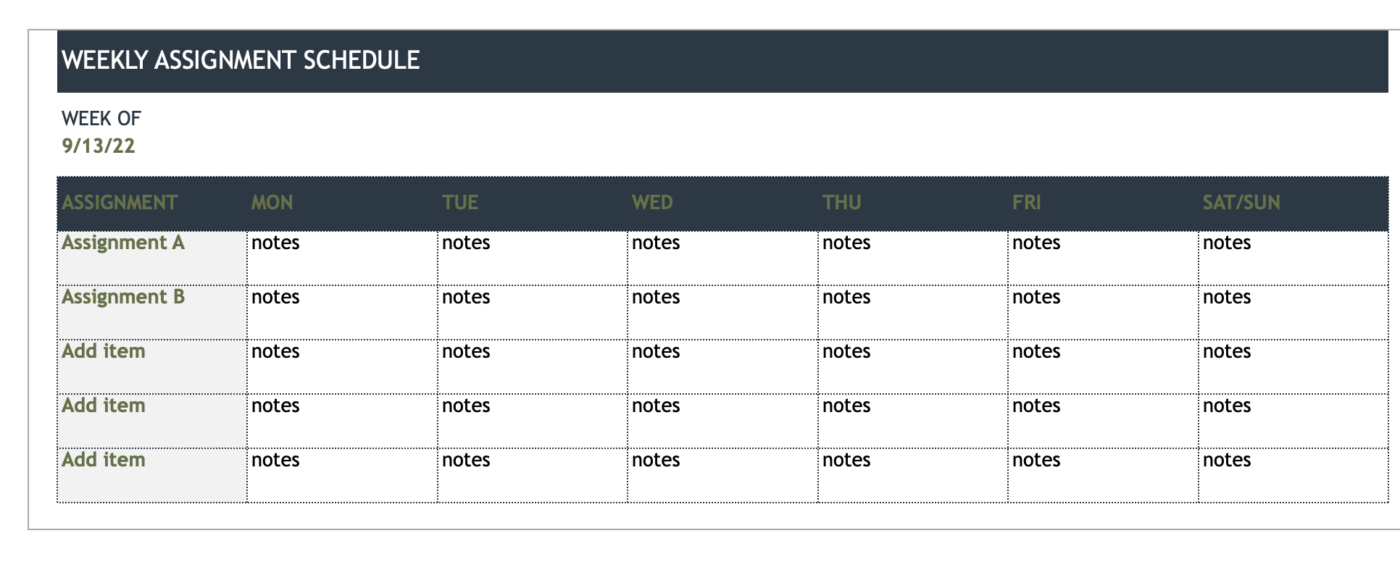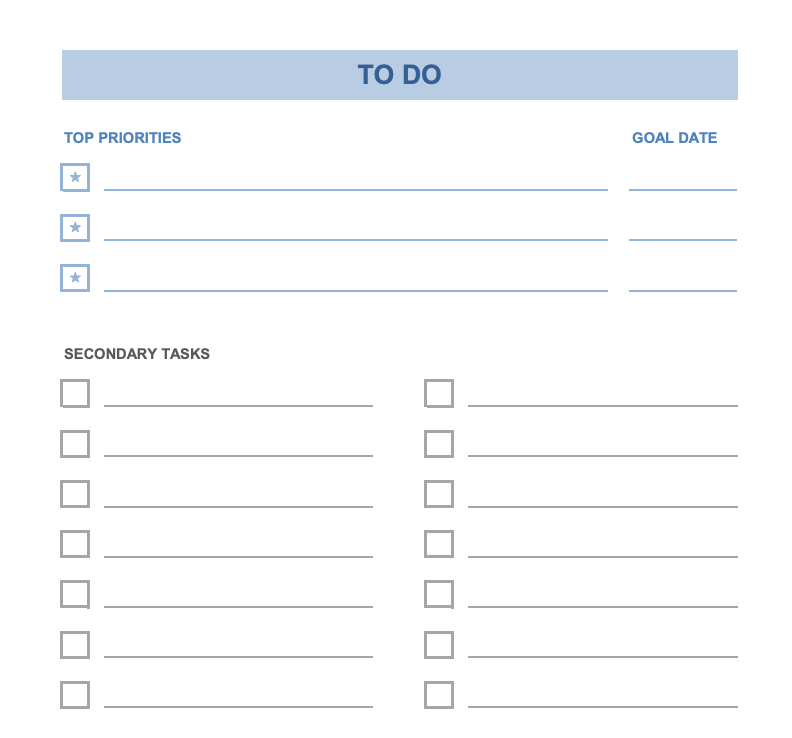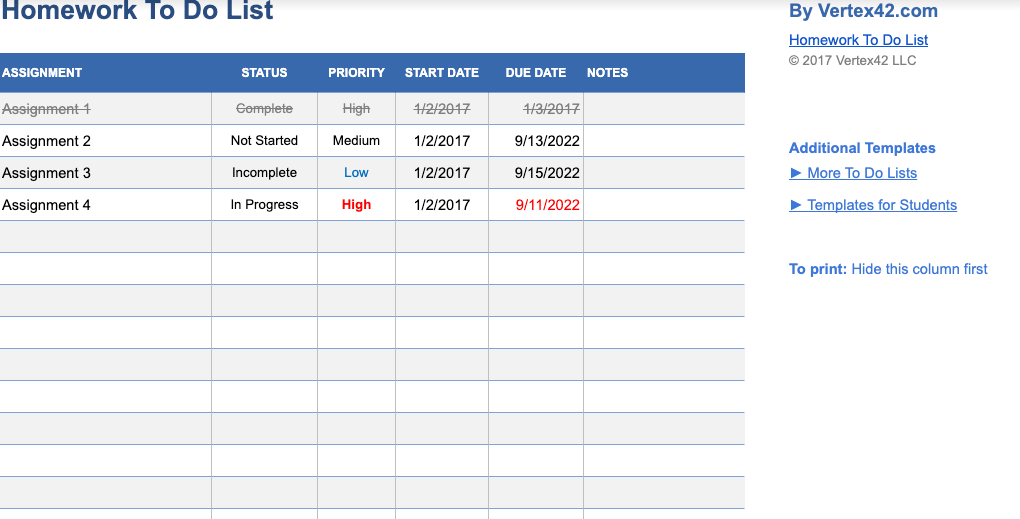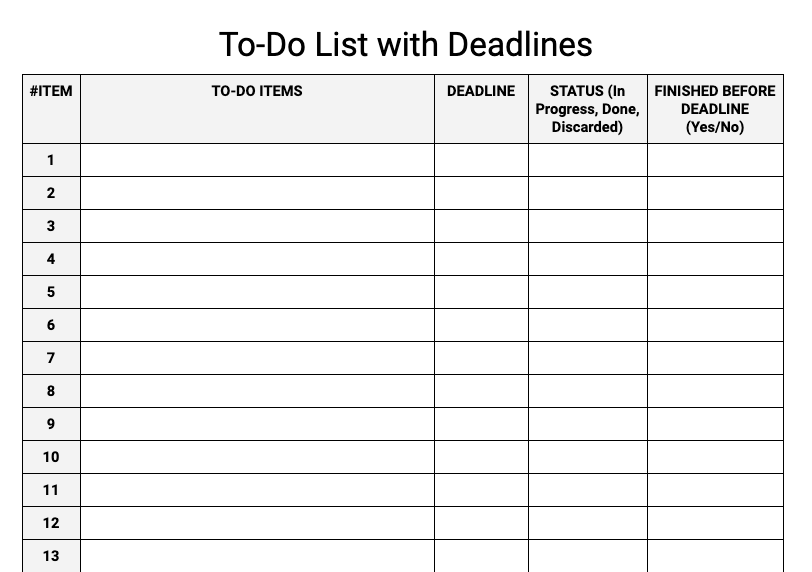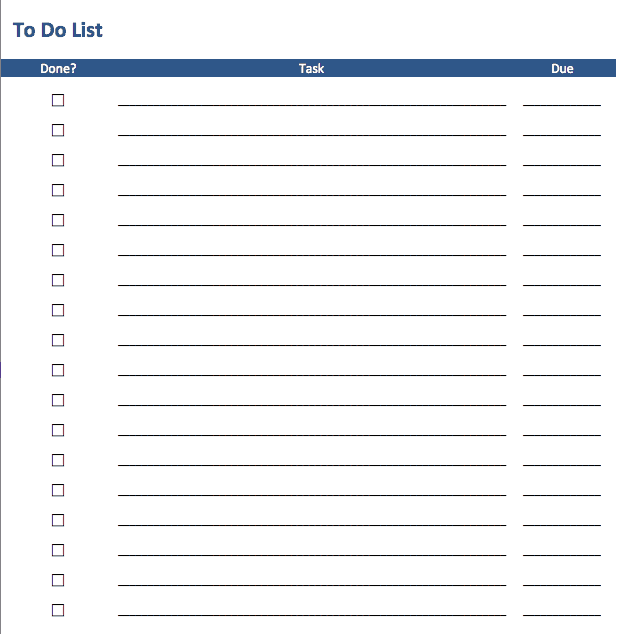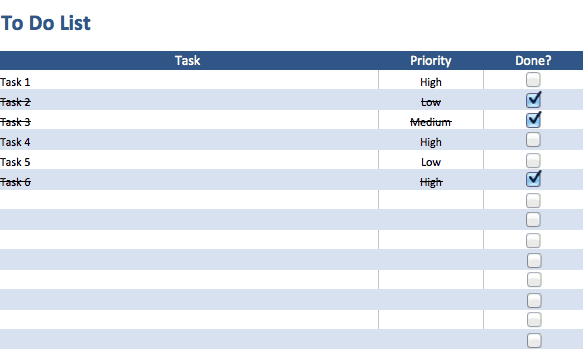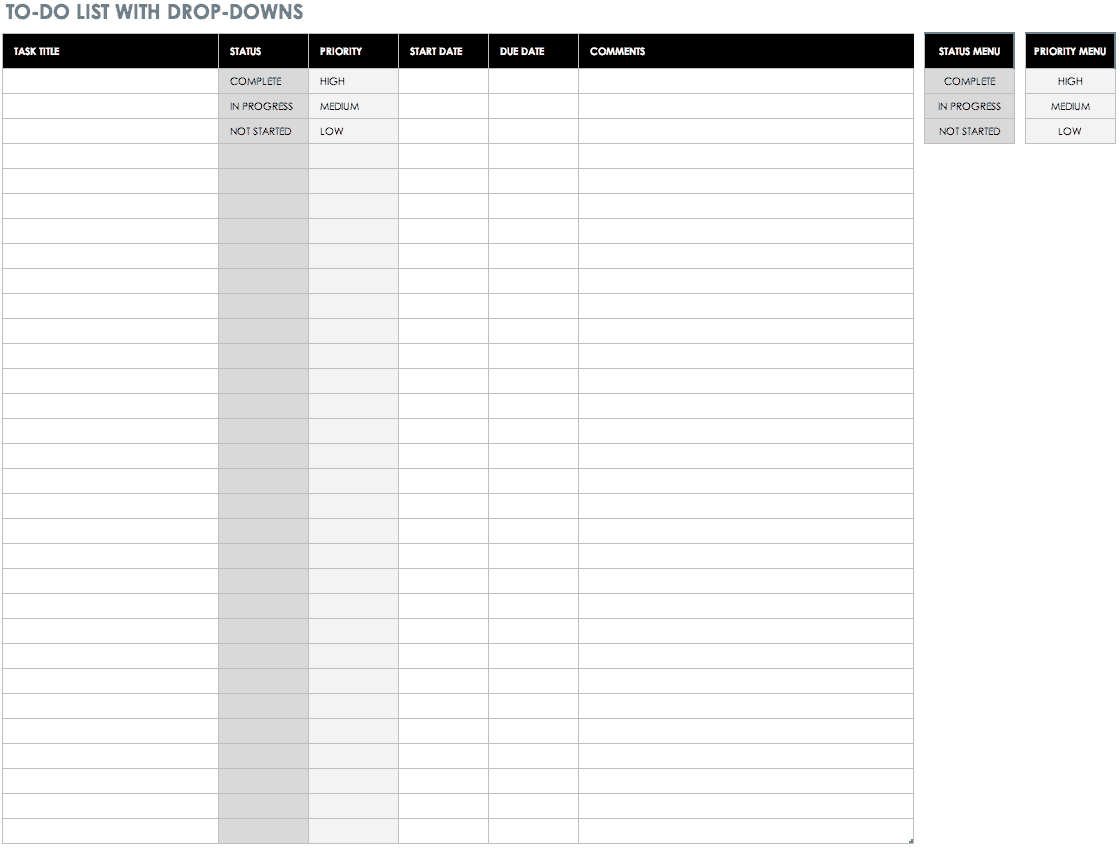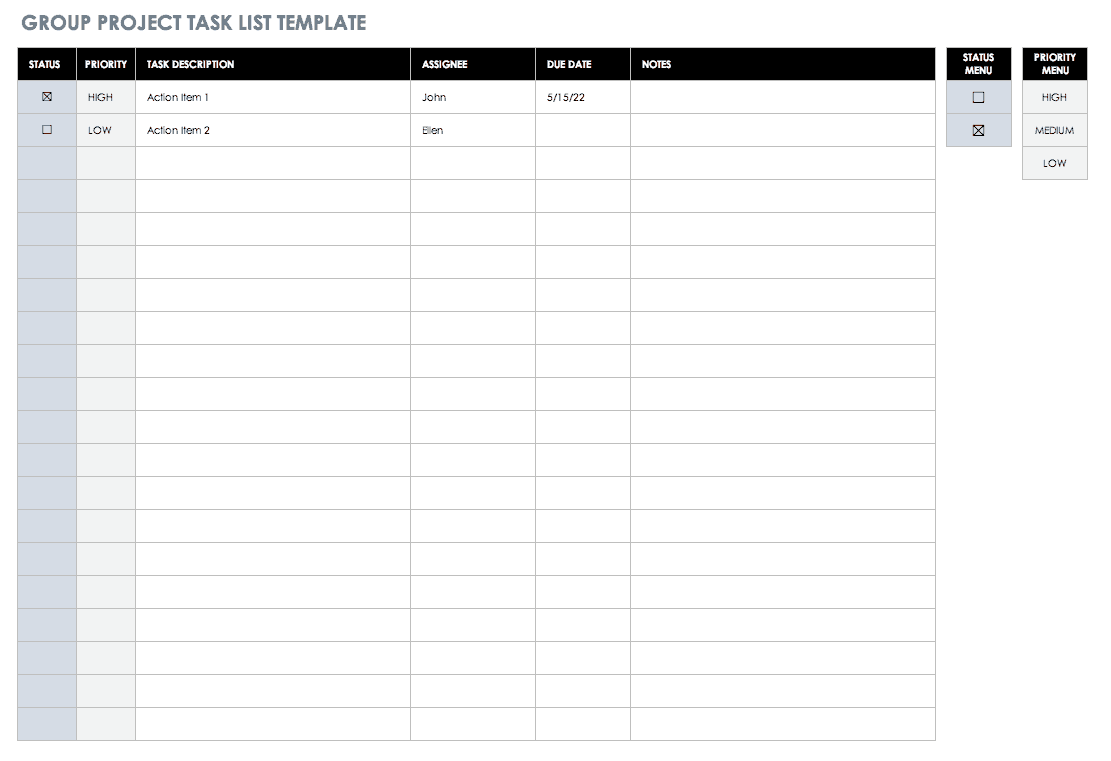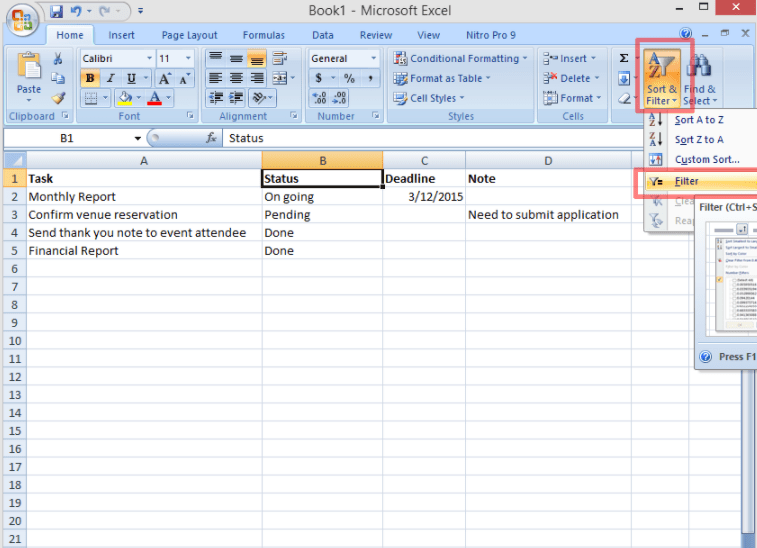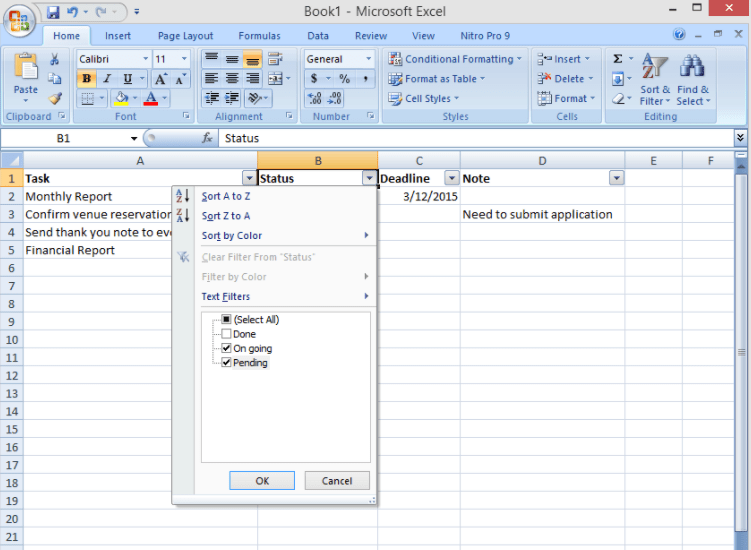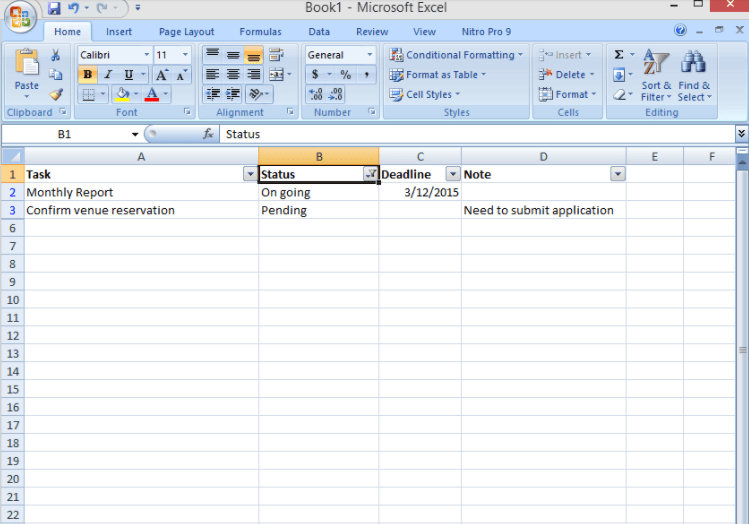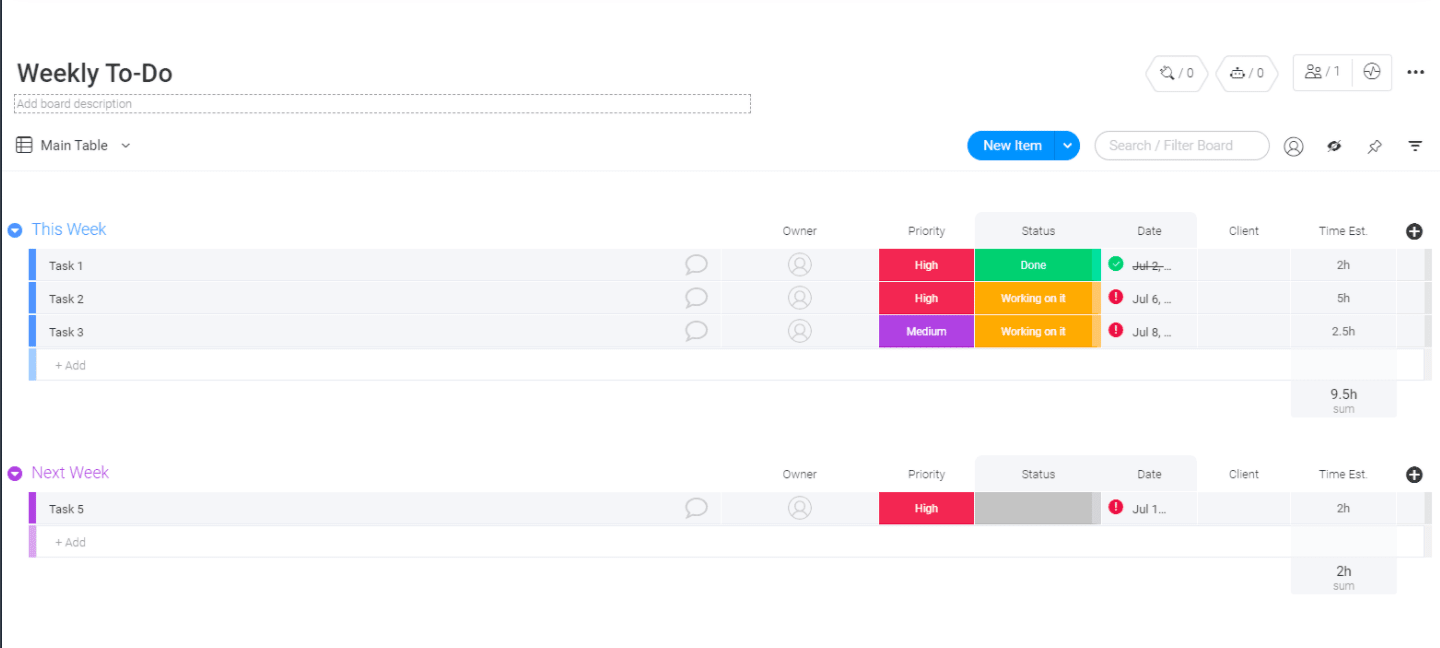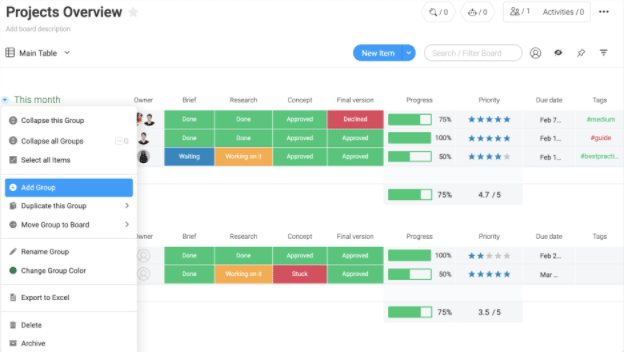The human mind is a powerful thing.
But sometimes, it can suddenly blank out!
Like forgetting to note down the grocery items missing in your pantry or the project changes your client wants by the end of the day.
While our brain can do quite a lot, sometimes relying on our memory isn’t always the best way to keep track of our tasks.
That’s why a to-do list in Excel can be helpful.
It helps you break down your tasks into different sections on a single spreadsheet, which you can view at any time.
In this article, we’ll cover the six steps to create a to-do list in Excel and also discuss a better alternative that can handle more complex requirements the easier way.
Let’s roll!

What Is a To Do List in Excel?
A to-do list in Microsoft Excel helps you organize your most essential tasks in a tabular form. It comes with rows and columns to add a new task, dates, and other specific notes.
Basically, it lets you assemble all your to-dos on a single spreadsheet.
Whether you’re preparing a move-in checklist or a project task list, a to-do list in Excel can simplify your work process and store all your information.
While there are other powerful apps for creating to-do lists, people use Excel because:
- It’s a part of the Microsoft Office Suite people are familiar with
- It offers powerful conditional formatting rules and data validation for analysis and calculations
- It includes an array of reporting tools like matrices, charts, and pivot tables, making it easier to customize the data
In fact, you can create Excel to-do lists for a wide range of activities, including project management, client onboarding, travel itinerary, inventory, and event management.
Without further ado, let’s learn how to create a to-do list in Excel.
6 Simple Steps To Make a To Do List in Excel
Here’s a simple step-by-step guide on how to make a to-do list in Excel.
Step 1: Open a new Excel file
To open a new file, click on the Excel app, and you’ll find yourself at the Excel Home page. Double-click on the Blank Workbook to open a new Excel spreadsheet.

If you’re already on an Excel sheet and want to open a new file:
- Click on the File tab, which will take you to the backstage view. Here you can create, save, open, print, and share documents
- Select New, then click on Blank Workbook
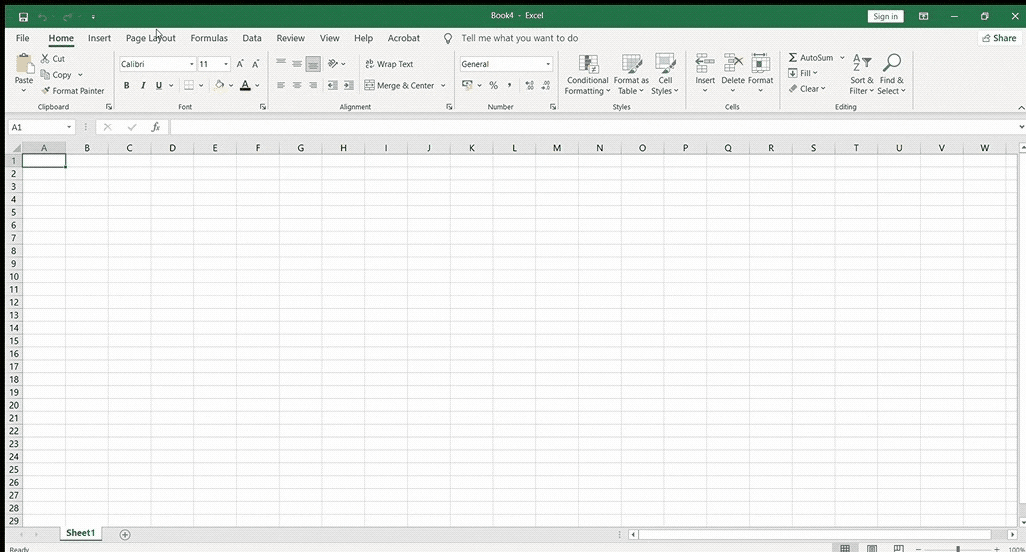
Want an even faster route?
Press Ctrl+N after opening Excel to create a Blank Workbook.
Your new workbook is now ready for you.
Step 2: Add column headers
In our Excel to-do list, we want to track tasks and keep an eye on the progress by adding the column headers: Date, Task Name, Target, Status, and Comments. You can enter the column headers across the top row of the spreadsheet.
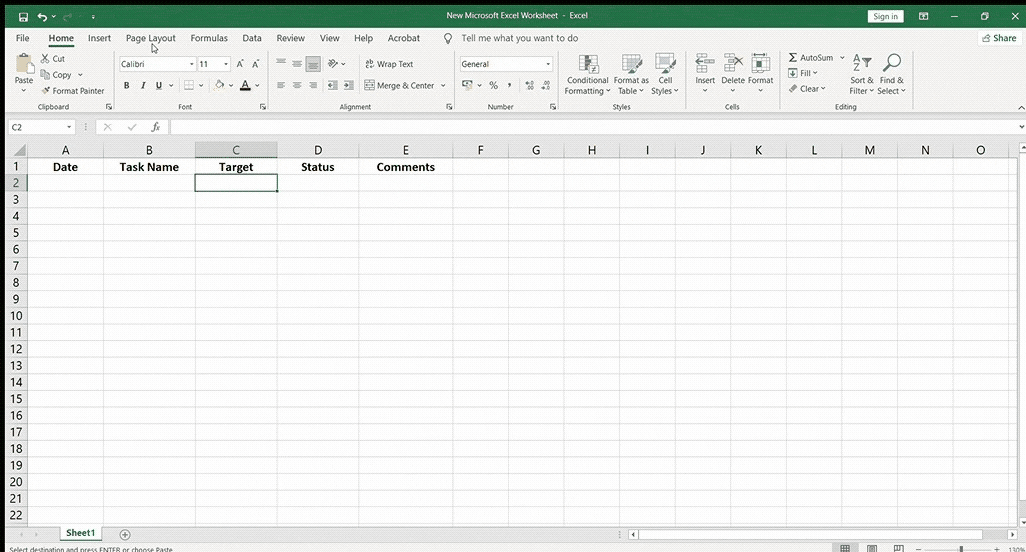
These column headers will let anyone viewing your spreadsheet get the gist of all the information under it.
Step 3: Enter the task details
Enter your task details under each column header to organize your information the way you want.
In our to-do list table, we have collated all the relevant information we want to track:
- Date: mentions the specific dates
- Task Name: contains the name of our tasks
- Target: the number of task items we aim to complete
- Status: reflects our work progress
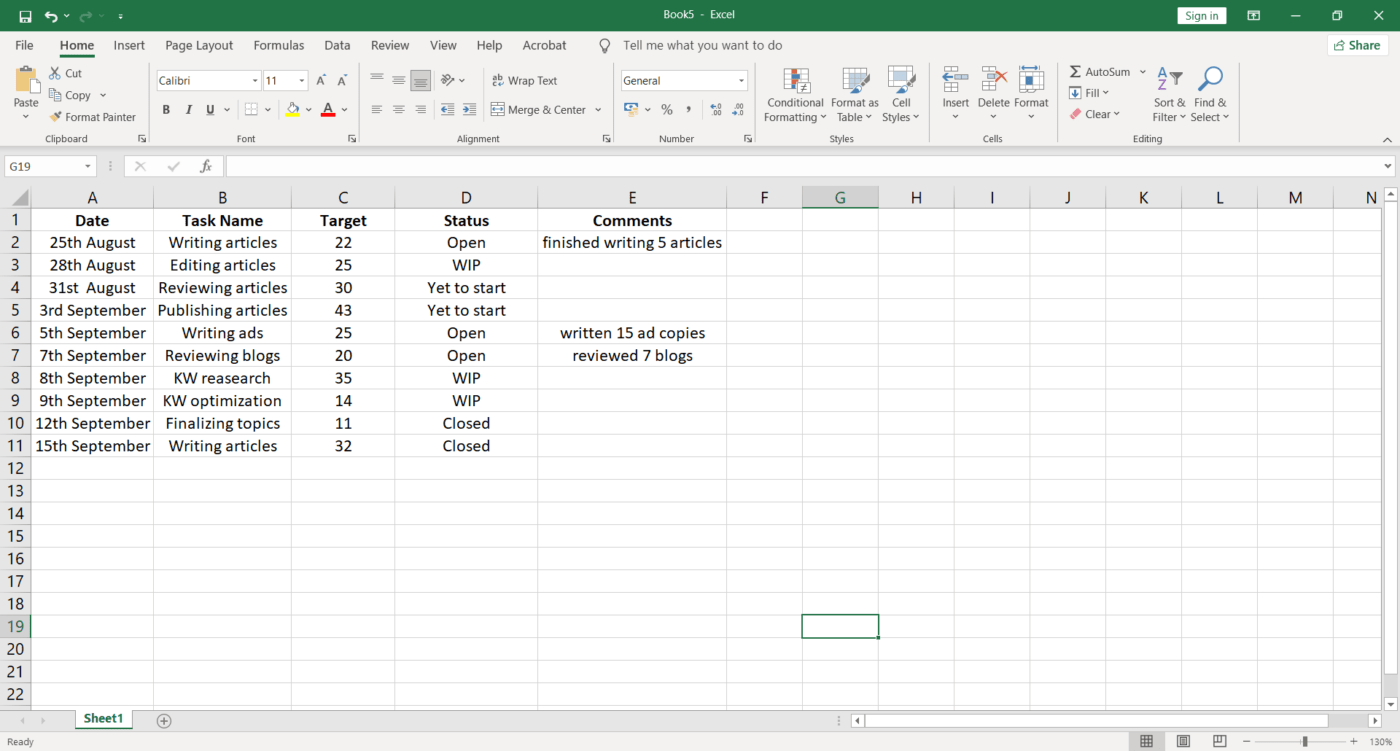
You can also fix the alignment of your table by selecting the cells you want and click on the icon for center alignment from the Home tab.
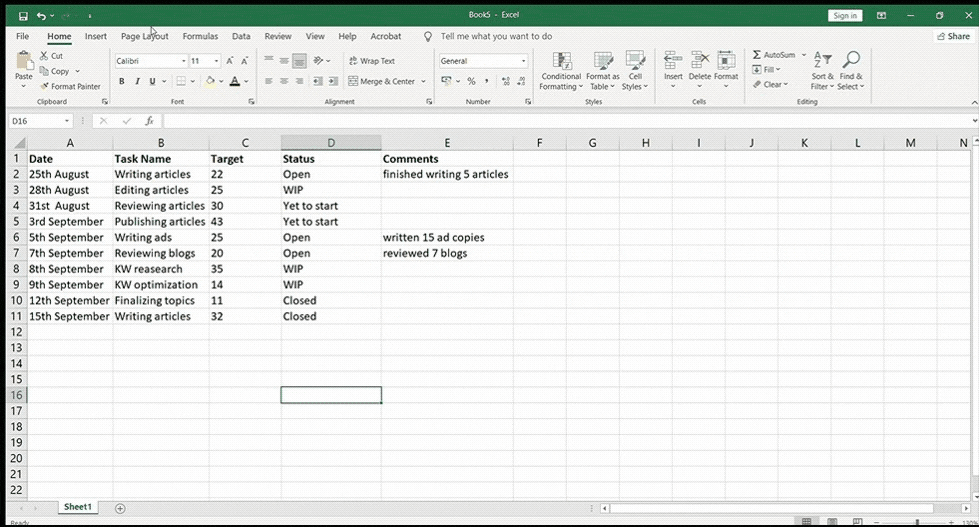
Step 4: Apply filters
Too many to-dos?
Use the Filter option in Excel to retrieve data that matches particular criteria.
All you need to do is select any cell within the range of your data (A1-E11) > Select Data > then select Filter.
You’ll see drop-down lists appearing in the header of each column, as shown in the image below.
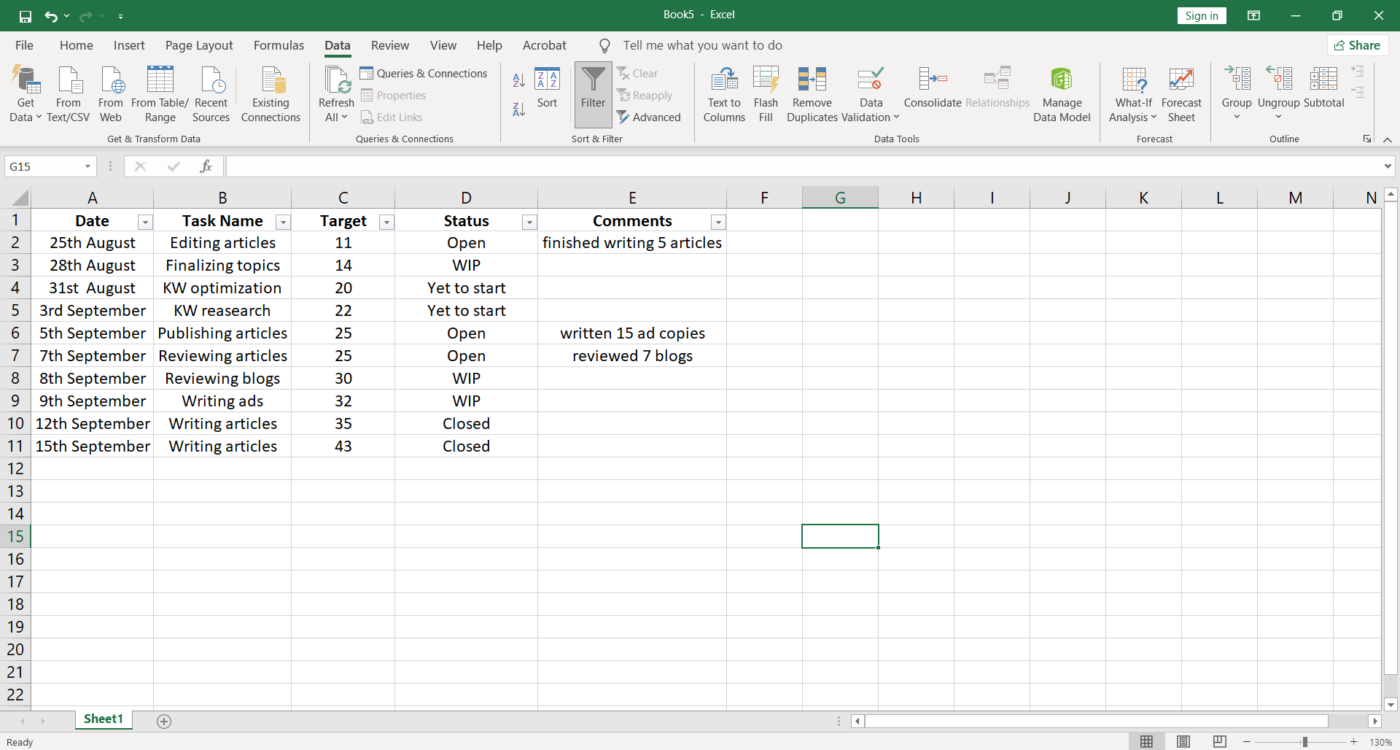
Click on the drop-down arrow for the column you want to apply a filter.

As shown in our to-do list table below, we want to apply the filter to the Status column, so we’ve selected the cell range of D1-D11.

Then, in the Filter menu that appears, you can uncheck the boxes next to the data you don’t want to view and click OK. You can also quickly uncheck all by clicking on Select All.

In our to-do list, we want to view only the Open tasks, so we apply the filter for that data.
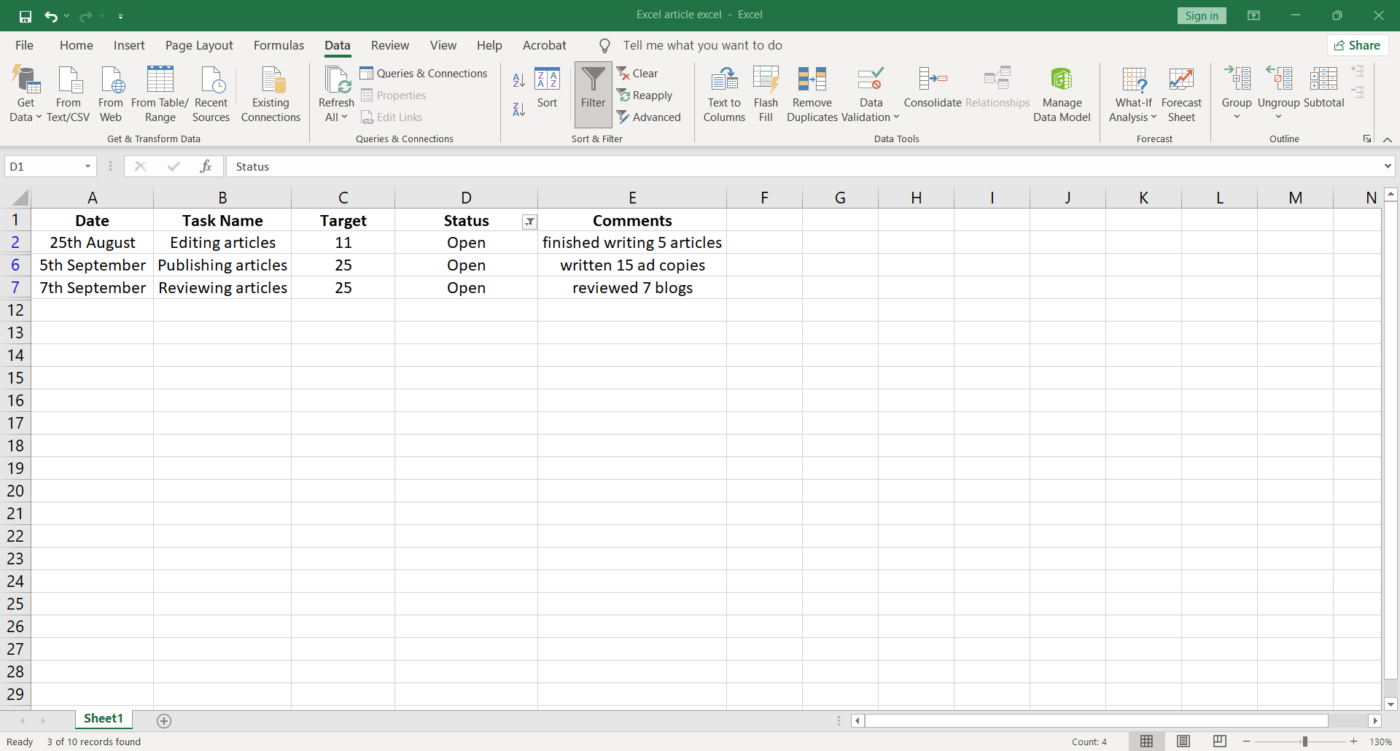
After you save this Excel file, the filter will be there automatically the next time you open the file.
Step 5: Sort the data
You can use the Sort option in Excel to quickly visualize and understand your data better.
We want to sort the data in the Target column, so we’ll select the cell range C1-C11. Click on the Data tab and select Sort.
A Sort Warning dialog box will appear asking if you want to Expand the selection or Continue with the current selection. You can choose the latter option and click on Sort.
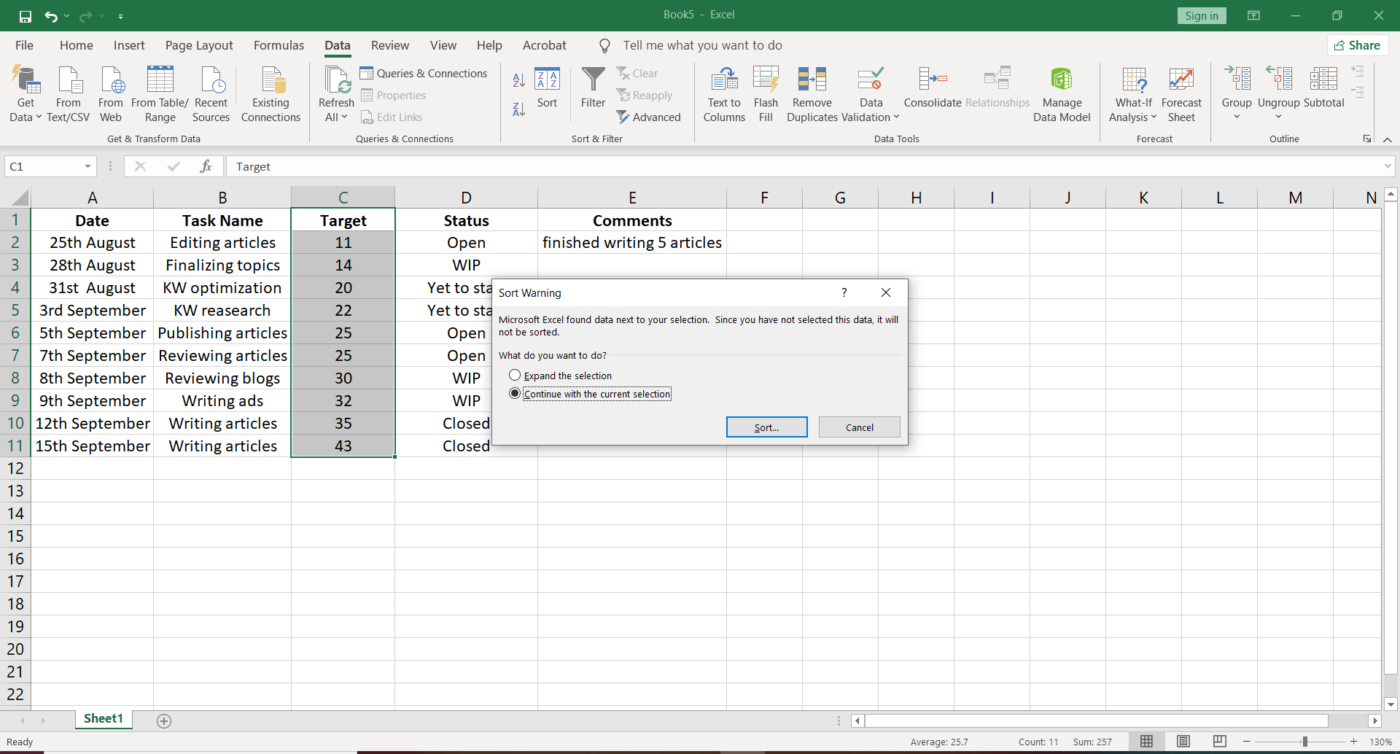
The Sort dialog box will open where you have to enter the:
- The column you want to Sort by
- Cell values you wish to Sort on
- Order in which you want to sort the data
For our table, we have chosen the Target column and kept the order from smallest to largest.

Step 6: Edit and customize your to do list
You can edit fields, add columns, use colors and fonts to customize your to-do list the way you want.
Like in our table, we’ve highlighted the Status column so anybody viewing can quickly understand your task progress.
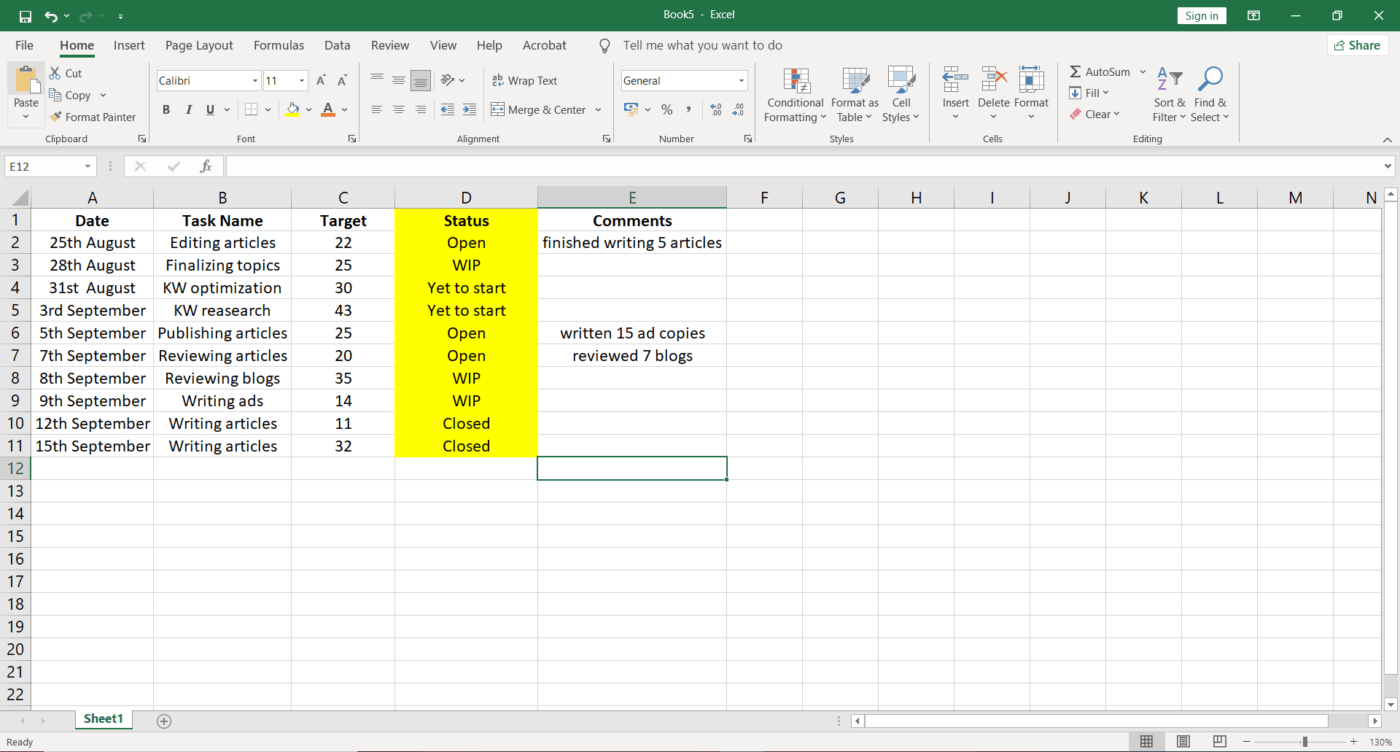
And voila! ✨
We’ve created a simple Excel to-do list that can help you keep track of all your tasks.
Want to save more time?
Create a template from your existing workbook to keep the same formatting options that you generally use while making your to-do lists.
Or you can use any to-do list Excel template to get started instantly.
10 Excel To Do List Templates
Templates can help keep your workbooks consistent, especially when they’re related to a particular project or client. For example, a daily Excel to-do list template improves efficiency and enables you to complete your tasks sooner.
Here are a few Excel to-do list templates that can help improve efficiency and save time:
1. Excel project management task list template
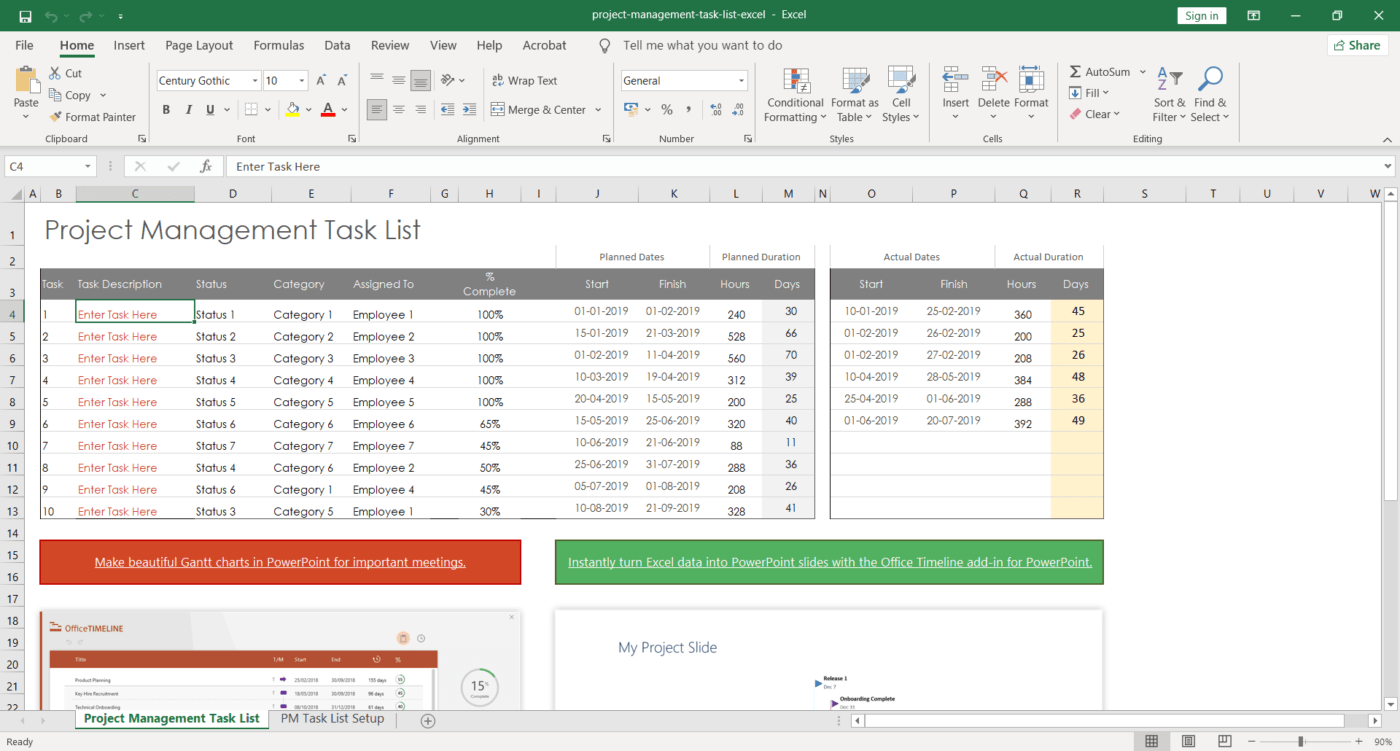
Download this project management task list template.
2. Excel inventory list template
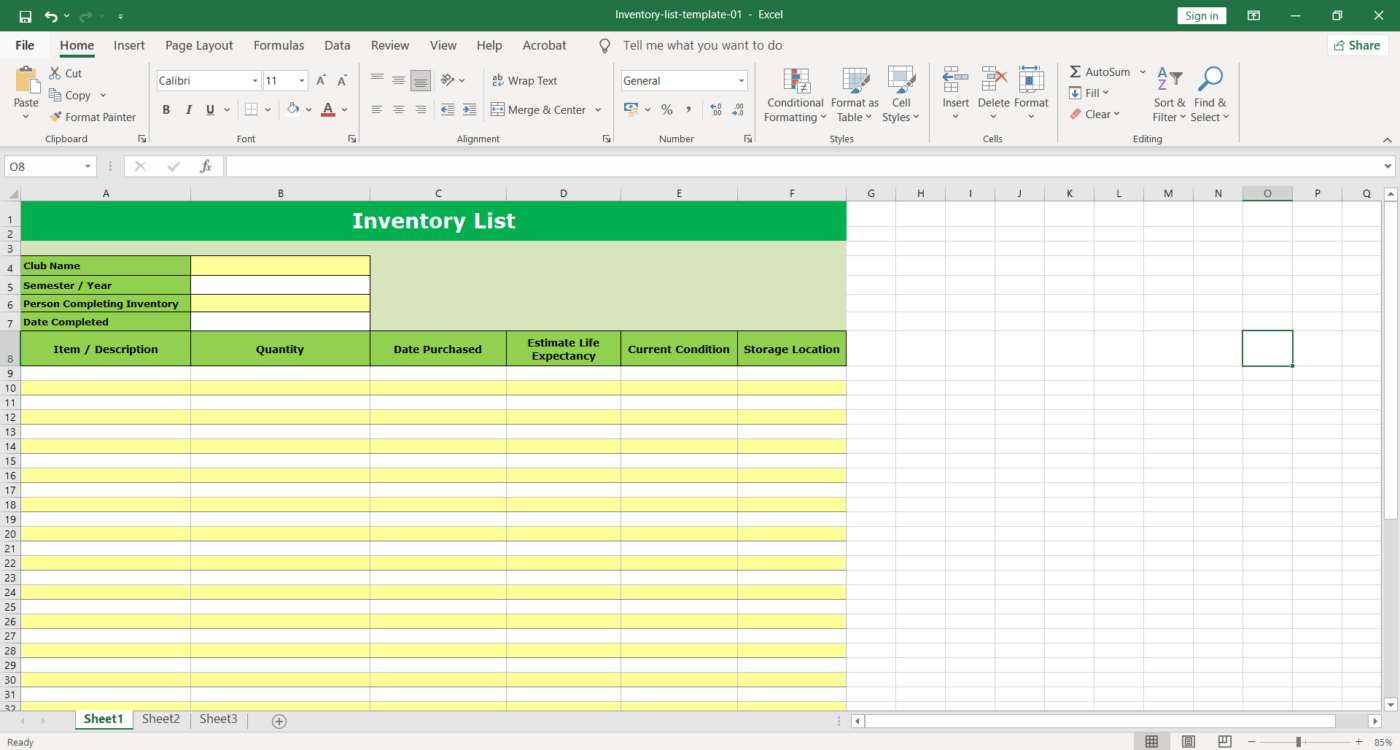
Download these inventory list templates.
3. Excel action item list template
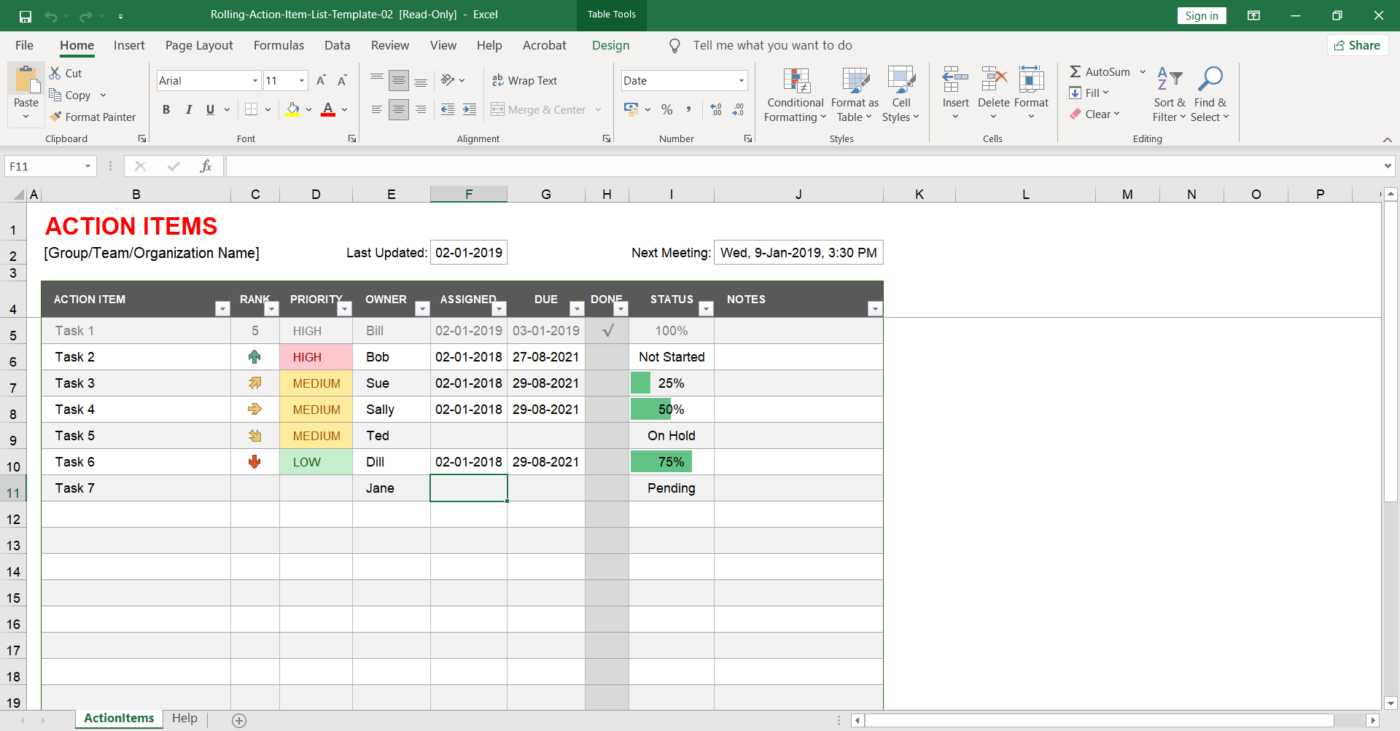
Download this action item list template.
4. Excel simple to-do list template
Download this simple to-do list template.
5. Excel bill paying checklist template
Download this bill paying checklist template.
6. Excel weekly assignment to-do list template
Download this weekly assignment template.
7. Excel prioritized to-do list template
Download this prioritized to-do list template.
8. Excel homework to-do list template
Download this homework to-do list template.
9. Excel to-do list with deadlines template
Download this to-do list with deadlines template.
10. Excel project task list template
Download this project task list template.
However, you can’t always find a template that will fulfill your specific needs.
Additionally, data management in Excel is prone to human error.
Each time a user copy-pastes information from one spreadsheet to another, there is a greater risk of new errors cropping up into successive reports.
Before you commit to Excel to-do lists, here are some limitations to consider.
3 Major Disadvantages of To Do Lists in Excel
Even though widely used, Excel spreadsheets aren’t always the best option for creating your to-do lists.
Here are the three common disadvantages of using Excel for to-do lists:
1. Lack of ownership
When multiple individuals work on the same spreadsheet, you’re unable to tell who’s editing.
You might end up repeating a task in vain if a person forgets to update the Work Status column in shared to-do lists after it’s done.
Additionally, people can easily alter task details, values, and other entries in the to-do lists (intentionally or unintentionally). You won’t know whom to hold accountable for the error or change!
2. Inflexible templates
Not all of the Excel to-do templates you find online are reliable. Some of them are extremely difficult to manipulate or customize.
You’ll spend forever on the internet to find one that works for you.
3. Manual labor
Making to-do lists in Excel involves a significant amount of manual labor.
It may take you quite some time to fill out your to-do items and create an organized system.
This doesn’t sit well with us because tons of project management tools can save you so much time and effort by creating and managing your to dos.
Moreover, the complexity increases with the increasing size of data in your Excel file. Naturally, you’d want a substitute to streamline your to-dos to track them and reduce the monotonous, manual work involved.
And honestly, Excel is no to-do list app.
To manage to-dos, you need a tool that’s specifically designed for it.
Like ClickUp, one of the highest-rated productivity and project management software that lets you create and manage to-dos with ease.
Related Excel guides:
- How to create a Kanban board in Excel
- How to create a burndown chart in Excel
- How to create a flowchart in Excel
- How to make an org chart in Excel
- How to create a dashboard in Excel
Create To Do Lists Effortlessly With ClickUp
ClickUp can help you create smart to-do lists to organize your tasks.
From adding Due Dates to setting Priorities, ClickUp’s comprehensive features let you create and conquer all your to-dos!
How?
One word: Checklists!
ClickUp’s Checklists give you the perfect opportunity to organize your task information so you never miss even the smallest of details.
All you need to do is click on Add beside To Do (you can find it within any ClickUp task), then select Checklist. You can name your Checklist and start adding the action items. Easy!

Easily organize task information so you never miss a beat with Checklists in ClickUp
Checklists within ClickUp give your tasks a clear outline. Apart from noting down the essential details, you also get subtasks to break down your tasks further.
You can also arrange and rearrange the checklist items with the easy drag-and-drop feature.

Reorganize your ClickUp Checklist by dragging and dropping your items
Worried about some tasks getting overlooked?
With ClickUp, you can add Assignees to your specific to-dos to see things through.

Manage items on your Checklist by assigning them to yourself or the team in ClickUp
It also lets you reuse your favorite Checklist Templates to scale your work efficiency.
To choose a template:
- Click Add from the To Do section of any task
- Click Checklist to reveal your options
- Choose a template and select Use Template

Use ClickUp’s Checklist Templates to stay efficient with different recurring tasks
Still hung up on Excel? That’s okay.
ClickUp’s Table view can help you move on.
But our Table view isn’t a mere matrix of rows and columns.
You can visualize your data clearly and create Custom Fields to record almost anything from task progress to file attachments and 15+ other field types.
Moreover, you can easily import your ongoing project details into ClickUp with our Excel and CSV import options!
But wait, that’s not all!
Here are some other ClickUp features that’ll make you forget Excel in an instant:
- Assign Task: assign tasks to one or Multiple Assignees to quicken your pace of work
- Custom Tags: effectively organize your task details by adding Tags
- Task Dependencies: help your teammates understand their to-dos concerning other tasks by setting Dependencies
- Recurring Tasks: save your time and effort by streamlining repetitive to-dos
- Google Calendar Sync: easily sync your Google Calendar events with the ClickUp Calendar view. Any updates in your Google Calendar will automatically reflect on ClickUp too
- Smart Search: search Docs easily and other items that you’ve recently created, updated, or closed
- Custom Statuses: denote the status of your tasks, so the team knows at which stage of the workflow they currently are
- Notepad: jot down ideas quickly with our portable, digital Notepad
- Embed view: declutter your screen and add the apps or websites alongside your tasks instead
- Gantt Charts: track work progress, assignees, and dependencies with a simple drag and drop functionality (check out this Excel dependencies guide)
Tame Your To Do Lists With ClickUp
Excel may be a decent option for planning daily to-dos and simple task lists. However, when you work with multiple teammates and tasks, Excel might not be ideal for what you need. Collaboration isn’t easy, there’s too much manual labor, and no team accountability.
That’s why you need a robust to-do list tool to help you manage tasks, track deadlines, follow work progress, and foster team collaboration.
Fortunately, ClickUp brings all of this to the table and so much more.
You can create to-dos, set Reminders, track Goals, and view insightful Reports.
Switch to ClickUp for free and quit wasting all that brainpower on simple to-do lists!
Love it or hate it, Excel is still an impressive piece of code. For over 30 years, spreadsheets have been the go-to tool for all kinds of projects, from not-so-exciting accounting & budgeting to AutoShape art or… flight simulators. But in today’s article, you’ll learn something different. Here’s how to create an Excel to-do list, complete with checkboxes, task sorting, and more.
Table of Contents
1
🤔 What Is a To-Do List in Excel?
We bet that creating an Excel to-do list wasn’t one of the “typical” use cases for the app Charles Simonyi—the brain behind Microsoft Excel—envisioned back in 1987.
But Excel’s columns, rows, and cells turn out to be a solid match for to-dos. Even if they’re not the most straightforward to set up. To make a to-do list in Excel you’ll need a few things:
- ☑️ Form Controls to insert checkboxes into a sheet.
- 🗂 Data Filtering to organize and filter tasks by their status.
- 🔠 Data Validation to define data entry rules for cells.
- 🎨 Conditional Formatting to change the appearance of cells.
All the components are here. All you need to do is figure out how to hack those features together (Dr. Frankenstein would approve). The good news is we’ve done the heavy lifting for you.
🏗 How to Create an Excel To-Do List (Step-by-Step)
Create a Blank Excel Workbook
Ok, this is an easy one. Your to-do needs a comfy space where it can grow long and lush. Here’s how to create a new Excel workbook with an empty sheet inside it:
- Open Excel and select Blank Workbook from the list
- You can also use the ⌨️ ⌘/Ctrl + N shortcut.
- Right-click the default Sheet1 at the bottom if you want to Rename your spreadsheet.
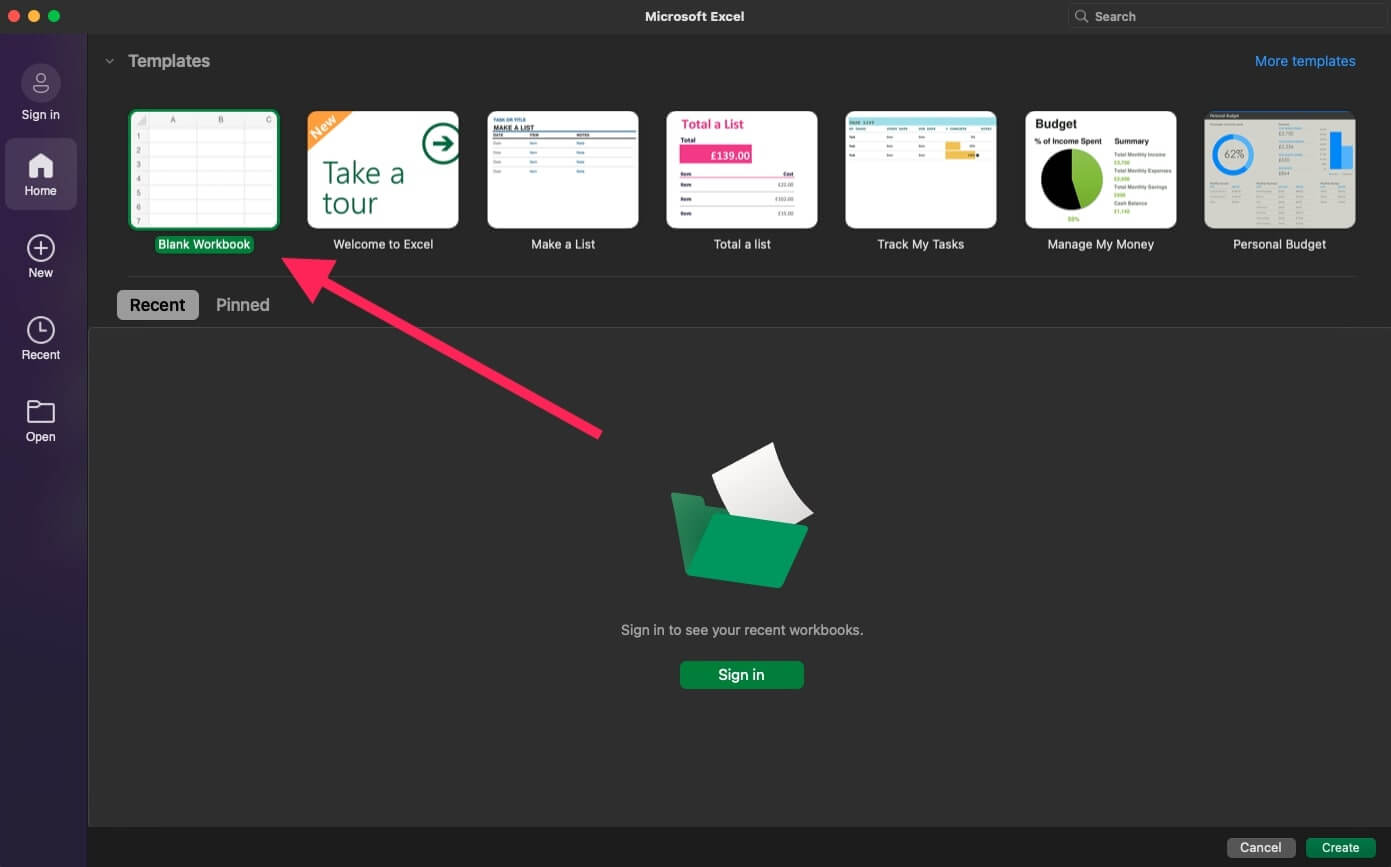
💡 Excel To-Do Tip #1: At this stage, you should also enable the Developer Tab that will let you add checkboxes to tasks later on. To do that, go to File ➡ Options (Excel ➡ Preferences if you're using a Mac) ➡ Ribbon & Toolbar, and check Developer under Main Tabs.
Organize Your List into Columns
It’s time to organize your blank sheet into labeled columns. Adding task parameters is a great way to add context to to-dos. It’ll also let you sort tasks down the road.
You can format your to-do list manually or use the Format as Table option in the Home tab. But first, let’s add a few headers to those freshly minted columns. Here are a few ideas:
- ☀️ Date Added
- 🔠 Description
- 🗓 Due Date
- ⏰ Time
- 🚥 Status
- 🚩 Task Priority
- 🗂 Category
- 📝 Comments/Notes
With that out of the way, let’s add a touch of color. Select the rows and columns of your soon-to-be to-do, click Format as Table in the Home tab, and choose one of the available styles.
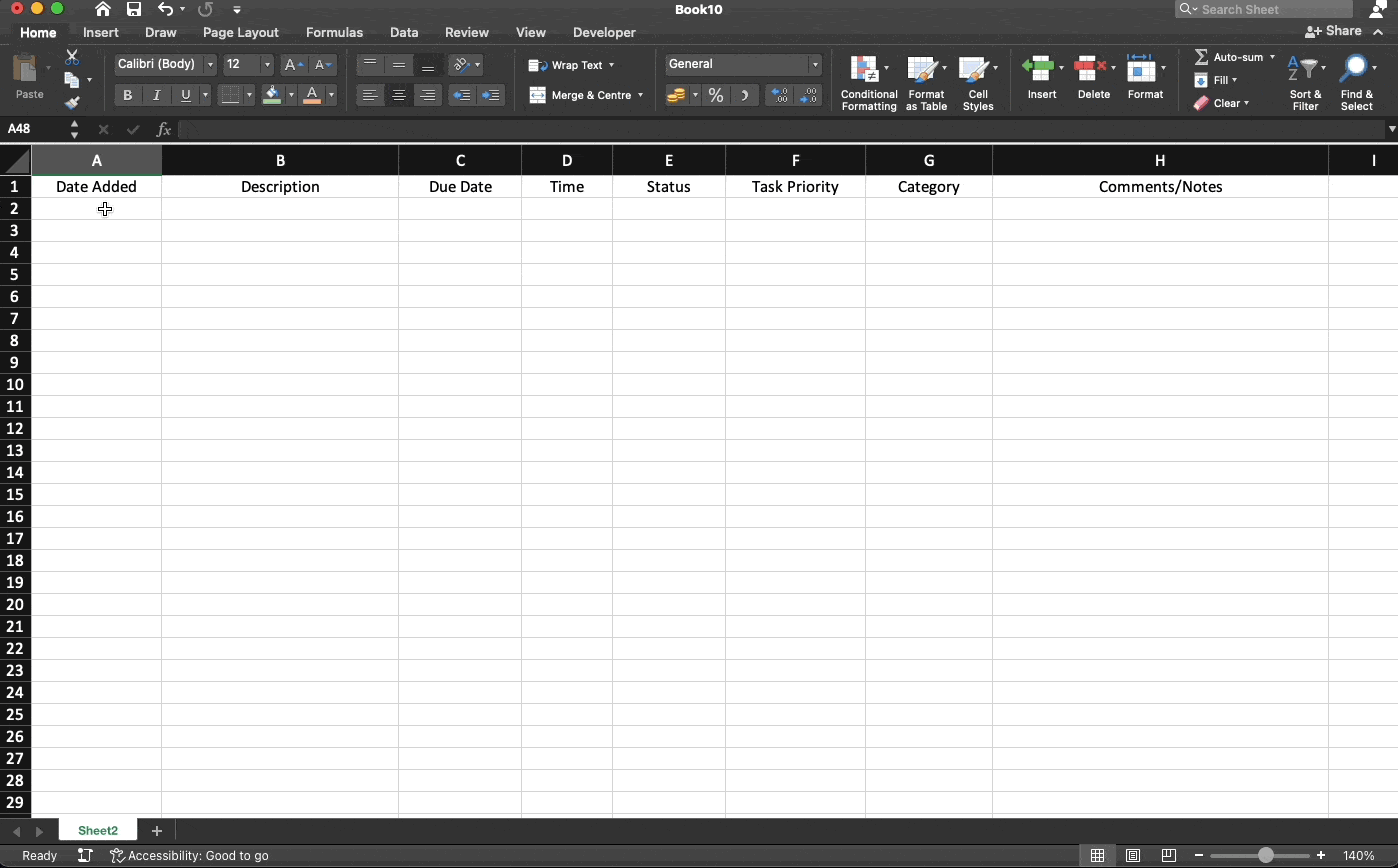
Experiment and add your own parameters but keep things low-key. After all, you don’t want to scroll through dozens of columns to complete a task, especially using a mobile version of Excel.
Trust us, it’s not fun.
💡 Excel To-Do Tip #2: You can apply conditional formatting to cells so their color changes depending on how important a task is. Try assigning each task a priority on a scale of 1-3 and select one of the available Conditional Formatting options from the drop-down menu.
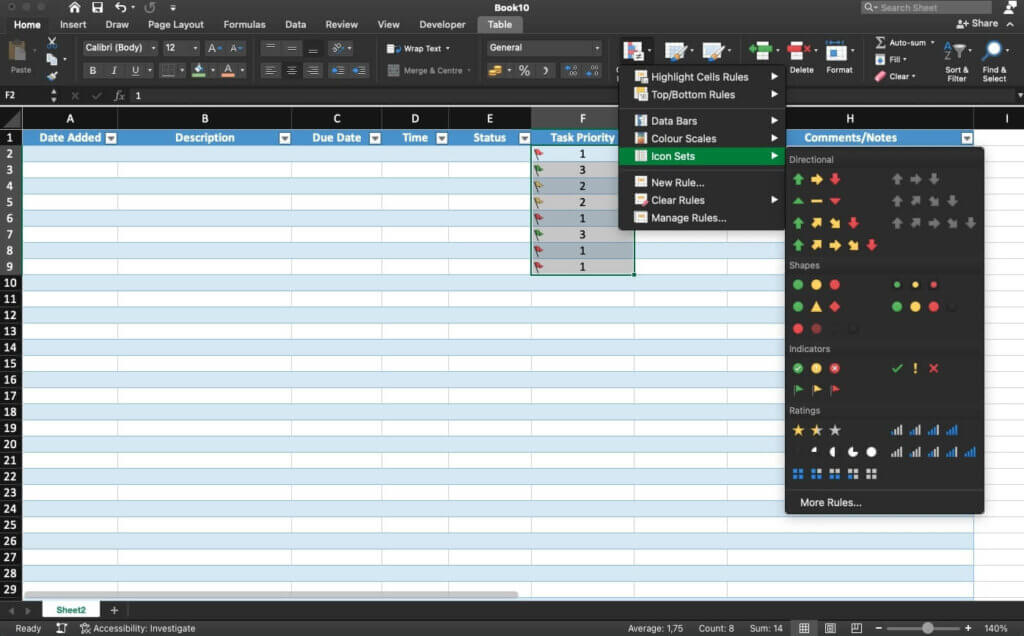
Enable Data Validation
Data validation lets you define the type of data you can enter into a cell.
Limiting your choices may seem counterintuitive. But it’s actually much easier to fill in details like task status using simple drop-down lists. Follow the steps below to enable data validation:
- Select all cells in the Status column
- Go to the Data tab ➡ right-click Data Validation.
- Under Allow, choose List from the drop-down menu.
- Choose the Source and click Ok to confirm.
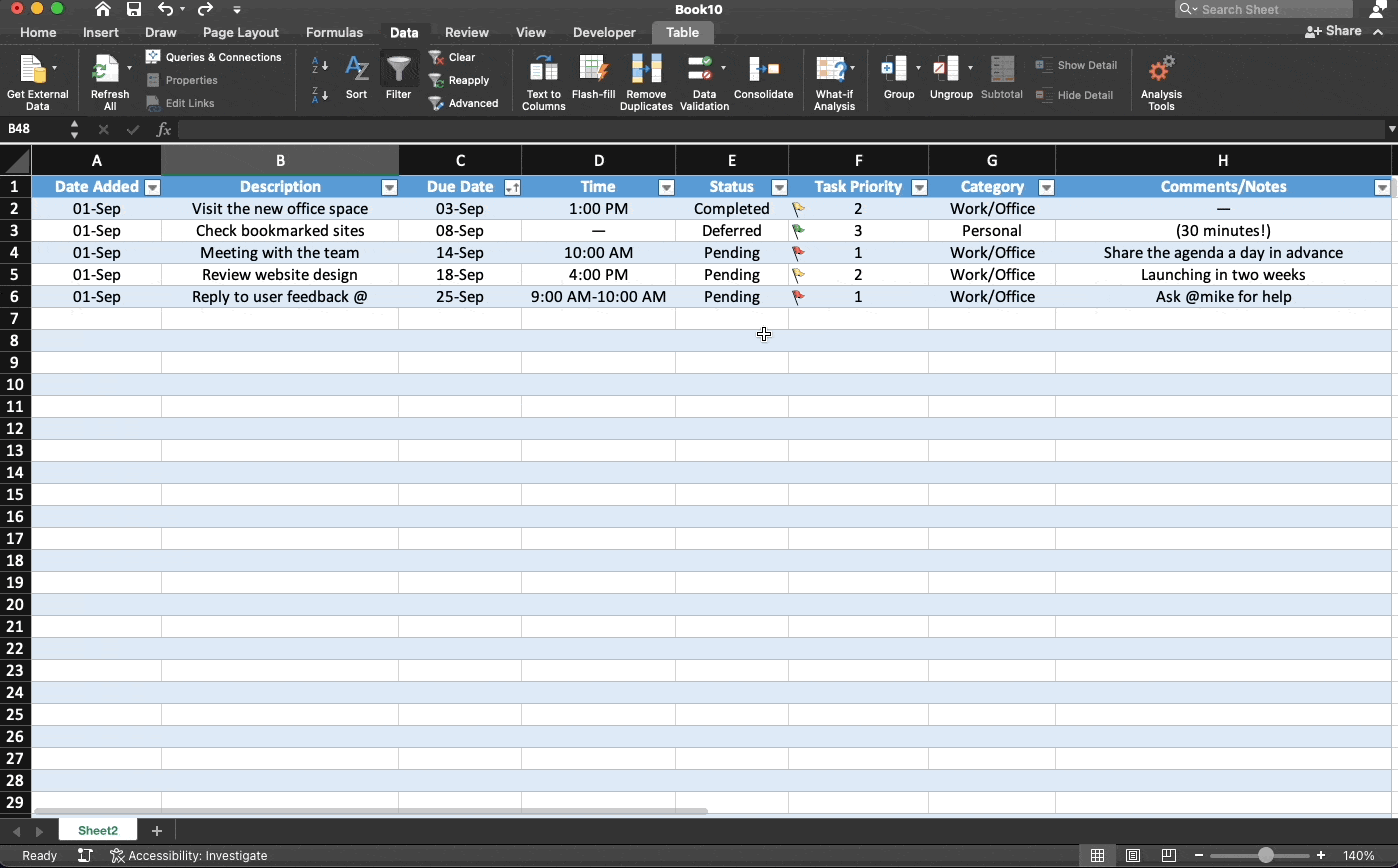
💡 Excel To-Do Tip #3: Try enabling data validation for other columns in the sheet. For example, the Task Category can include options like “Work” and “Personal.”
Add Checkboxes to Your Tasks
What good is a to-do list if you can’t “check” ( or “tick”) completed tasks? We’ve already enabled the Developer tab in the previous steps so you can now add checkboxes to the spreadsheet.
- Go to the Developer tab ➡ click ☑️ Checkbox.
- Select the cell where you want to add the checkbox.
- Resize the checkbox and place it in the center of a cell.
- Drag the fill handle to duplicate the checkbox across all tasks.
And that’s it! 🥳
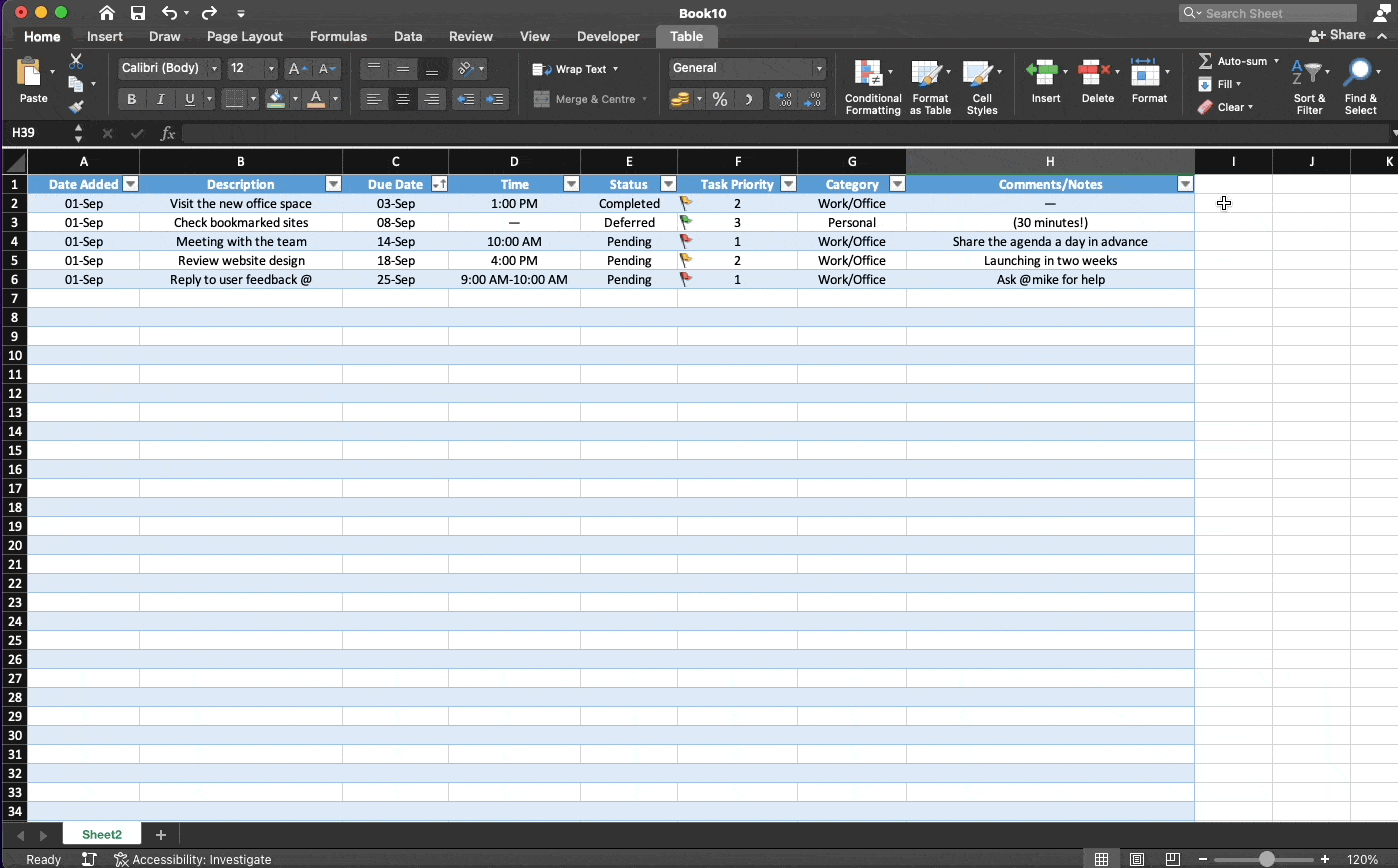
👎 Disadvantages of Using Excel For Managing Your To-Do Lists
Excel Is Not a To-Do List App
Let’s make one thing clear.
It’s not that an Excel spreadsheet CAN’T act as an over-engineered to-do list. Quite the contrary. Excel is a powerful tool, but getting it to work requires a great deal of “figuring it out.”
Need a simple progress bar to check your progress?

Sorry, there’s none. Sure, you can insert a chart and come up with a witty formula to make it somewhat interactive. But the best online to-do apps let you track progress out of the box.
If you want to adapt an Excel spreadsheet to a task that’s not data entry, you need to hack together different features to get the results you’re after. And that’s not really “user-friendly.”
Of course, all that hacking and tinkering comes with a price.
Let’s say you’ve put together a few formulas and macros to power your to-do list. They seem to work just fine, so you get on with your work and forget all about them.
But the moment you start scaling your list, things get messy. The spreadsheet becomes laggy and unresponsive, formulas stop working, and you need to waste time figuring out what’s wrong. If you’ve ever used Excel, that scenario probably sounds all too familiar.
The bottom line is that Excel is NOT a to-do list app. It wasn’t designed to be one and doesn’t even have the basic functionality that’d make tracking tasks easier. And speaking of features…
You Don’t Get Any Dedicated To-Do Tools
Let’s start with reminders.
Excel spreadsheets don’t offer a straightforward way to set reminders out of the box. You can hack this functionality using Data Validation and other methods. But, as is the case with workarounds, it takes time and effort you should spend on getting work done.
Oh, and unless you’re an Excel pro, we wouldn’t put too much trust in those reminders anyway.
If you want to track tasks with multiple dependencies, you’re in for a ride. Unless you want to cram cells full of text, there’s no simple way to add sub-tasks to your to-do lists. Sorry not sorry.

It’s hard to imagine a to-do list that doesn’t use checkboxes or a variation of those.
Adding them to a spreadsheet? It’s possible, but you probably know by now that that’s a rather unintuitive process. That’s unless you love copying, pasting, and resizing. We don’t.
Of course, Excel is completely devoid of any advanced to-do features like drag & drop navigation, cross-linking, or a dedicated mobile app that’d let you easily—we can’t emphasize that enough—check tasks on the go. And it’s unlikely that things will change anytime soon.
Collaboration Is Not Exactly “Smooth”
Collaborative task management has proved its worth during the work-from-home experiment. And it’s still gaining traction as more teams are adopting a fully distributed or hybrid model.
While Excel does offer some collaborative features, they’re pretty limited.
You can’t assign tasks or tell what other people are working on in a straightforward way. There’s also no master view that’d make it easy to track team performance in a high-level overview.
A formula stopped working? Your teammate messed up conditional formatting?
It’s one thing when you make a mistake and your local spreadsheet crashes. But locking 10, 20, or 30 people out of a spreadsheet so you can fix a formula is a massive productivity killer.

And let’s not forget about Excel’s technical limitations. And there are quite a few
For once, Excel isn’t just one app that works across all devices. There are different apps for the web, desktop, and mobile, and not all of them support co-authoring. If you use a version that doesn’t, everybody else in the sheet will get locked out until you’re done with editing.
But hey, we’re not here to create problems but to find the right solutions. 🥳
🐑 Taskade—An Easier Alternative to Creating To-Do Lists in Excel
Creating a reliable to-do list for work and personal errands doesn’t have to be hard.
Erm… as long as you’re using the right tool for the job.
Taskade lets you plan, organize, and keep track of your to-dos the easy way. You don’t have to “hack” anything or create intricate formulas to stay on top of every task. With Taskade, everything works out of the box so you (and your team) can start getting work done in seconds.
Check this short video introduction to see how it works! 👇
But wait, that’s not all.
Taskade packs in a fine roundup of to-do features, including:
- ⏰ Due dates and recurring tasks
- 🦅 High-level overview of project status
- ⌨️ Convenient keyboard shortcuts
- 🔠 Natural Language Processing (NLP)
- 🎨 Text and checklist formatting
- ↕️ Task sorting and drag & drop navigation
- 🔔 Customizable push notifications
- 🔎 Global search, version history, and #hashtags
- 🔗 File uploads, embeds, and attachments
- And much more!
You can easily collaborate and chat with friends, family, and team members by inviting them directly to the Project. Taskade also features dynamic project views that let you instantly transform your list into a board, table, org chart, calendar, and even a mind map!
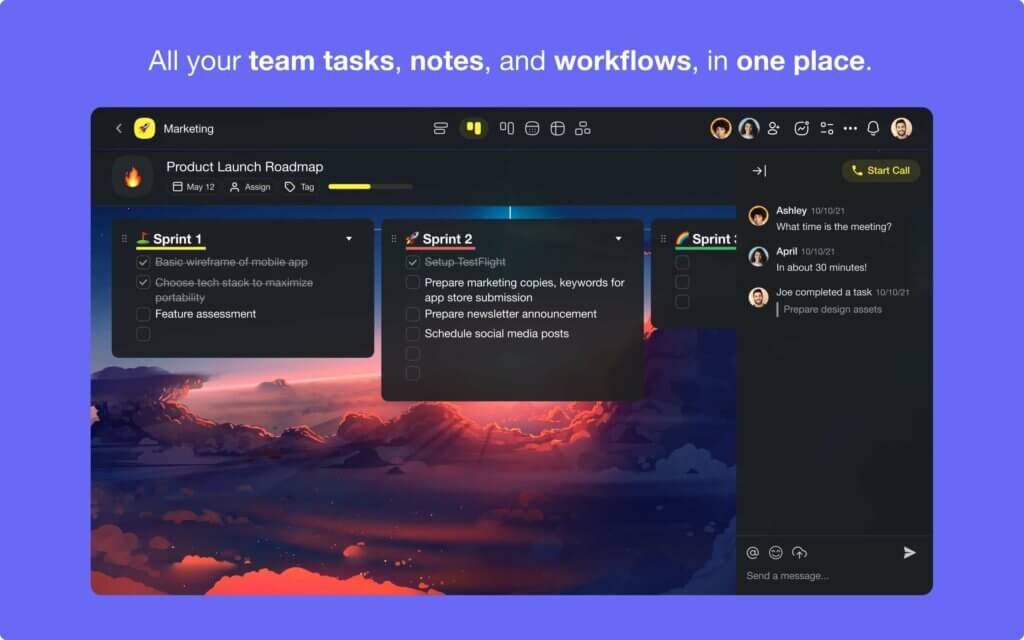
Taskade syncs your to-dos across all your devices without limits, even in the free plan. Our apps work natively on Mac, Windows, Linux, and mobile (iOS, Android). You can also access your to-dos in a web browser, just in case you somehow forget to bring all your devices for the trip.
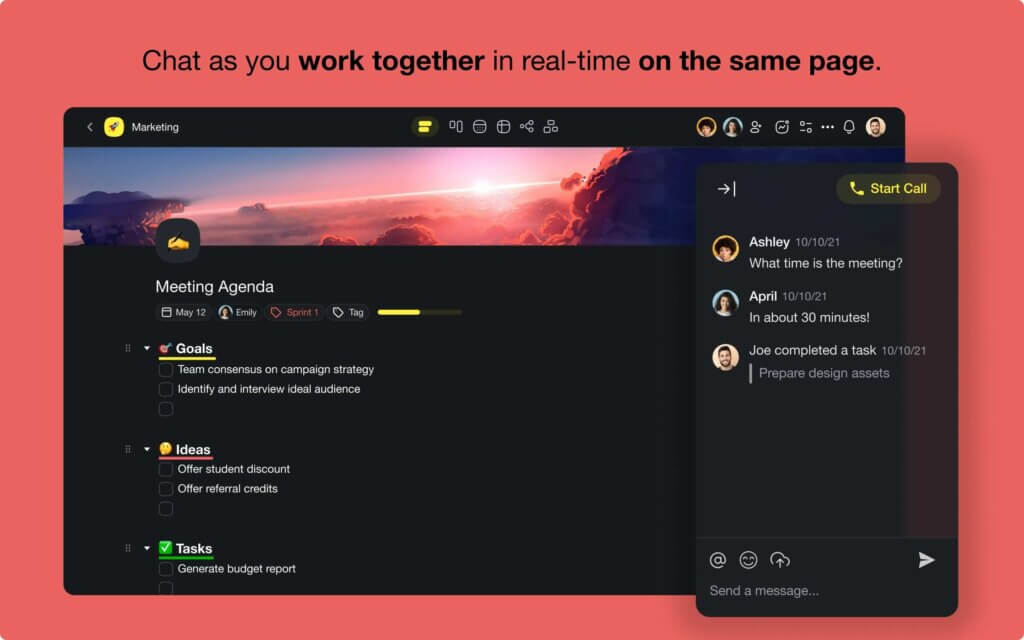
“Is that all?” Nope, but we don’t want to bog you down with all the features Taskade offers.
Where’s the fun in that?
Sign up for a free Taskade account and explore the app for yourself. Our free tier includes a ton of options so you can get started quickly without silly limitations.
Oh, and don’t forget to bring your team on board!
👋 Parting Words
Can you create a project task list in Excel? Sure.
Should you? That’s a question you must answer yourself.
If you like to tinker with formulas and macros or spend hours setting things out, you’ll enjoy the process. But if you just want to get work done, you should use a dedicated to-do tool instead.
✋ Before you go… Check these articles next to learn more about the power of lists!
- History of the To-Do List and How to Get Yours Organized
- The Power of Checklists in Distributed Teams
- A Case For Hierarchical Thinking: Solve Complex Problems The Easy Way
In this guide, we’re going to show you how to create a To-Do list in Excel with the help of checkbox controls and conditional formatting.
Download Workbook
Preparation before creating a To-Do list
Start by creating a 3-column range for the to-do list. These columns can include:
- To-Do items
- Checkboxes for status
- Helper column for storing the values of checkboxes
Checkbox controls can go under the status column. You can add multiple checkboxes by creating one inside a cell and dragging it down for the rest.
See how to insert a checkbox in Excel for more details on how to add checkbox controls.
Once the checkboxes are ready, link them to adjacent cells under the Helper column.
Once linked, check and uncheck the checkboxes to make sure they are linked correctly. You will see that cells in the Helper column show either TRUE or FALSE value based on the checkbox selection.
Helper column is actually optional. Now, let’s take a look on further customization options for our To-Do list.
Adding conditional formatting
Conditional formatting is great way to help distinguish completed and not-completed items.
- Select all of to-do items in your list.
- Open the New Formatting Rule window by following Home > Conditional Formatting > New Rule.
- Select Use a formula to determine … item in New Formatting Rule
- Enter a formula which is using the NOT function with the reference of the first cell of the Helper. Be sure to leave the row part relative: =NOT($D5) (Relative reference is important to let Excel copy the formula to other cells in the column).
This formula allows you to format unchecked items, because FALSE will become TRUE thanks to the NOT function. TRUE tells Excel to apply the determined format. - Click the Format button to open Format Cells
- We selected a grey font color and strikethrough font type to express completed items.
- Click OK buttons in all windows to apply the formatting.
Once the formatting is applied, you will see something like below.
If you are satisfied with the result, just hide the helper column and you’re done. Next, we are going to place a progress indicator.
Progress
Since we are already keeping the values of checkboxes in the helper column, we can count them and calculate the ratio of checked items. The COUNTA and COUNTIF functions can help here.
If we name Helper column as «Helper», the formulas will be like below.
Count of all items: =COUNTA(Helper)
Count of completed items: =COUNTIF(Helper,TRUE)
Ratio of completed items: =Completed_Items/All_Items
While the COUNTA function counts cells that contain a text, the COUNTIF function counts the cells containing only TRUE. The ratio between two gives us the progress.
You can also add a visualization to display this information. Although Excel doesn’t have a visualization called «progress bar», you can create one by modifying a bar chart.
- Insert a bar chart by following Insert > Insert Column or Bar Chart > Clustered Bar (2-D Bar).
- Right-click on your chart area and click Select Data.
- Use Chart data range input to select the ratio.
- Click OK to see the chart. With a couple of visual modifications, this bar chart will become a progress bar.
- Double-click on the vertical axis to see the options. Open Axis Options and set Minimum to 0 and Maximum to 1.
- Remove the vertical axis.
- Remove the title.
- Shrink the area by decreasing the height.
- Add border to the Plot Area by right-clicking and setting Outline
- Decrease the Gap Width.
You can learn more customization options for the bar chart here: Bar Charts
Содержание
- 1 Excel To Do List Templates (Free Download)
- 1.1 Common Use Cases of Using these To-do list templates
- 2 Steps to Creating a To Do List in Excel
- 3 Adding check boxes in your to-do list
- 4 To Do List Templates (Excel)
- 4.1 Task To Do List Template
- 4.2 To Do List with Due Date (Excel)
- 4.3 Priority To Do List Template (Excel)
- 5 Conclusion
- 6 1. Simple Drop-Down Lists via Data Validation
- 7 2. Conditional Formats for the Priority Column
- 8 3. Conditional Formats for Numeric Priority
- 9 4. Checkboxes using Form Fields
- 10 5. Checkboxes via Data Validation
- 11 6. Progress Bar for % Completed
- 12 7. Gray-Out Tasks When They are Complete
- 13 8. Highlighting Overdue Dates
- 14 9. Autofilter and Sorting
- 15 10. Create a Gantt Chart
- 16 11. Drop-Down with Current Date
- 17 Ссылки
You start your day. Plan some tasks. Write it down somewhere and start working on it.
When it’s way past your work time, you think about that to-do list (stare at it if you have it written) and curse the world for not having enough time in the day.
Sounds familiar?
If you are nodding your heading in agreement, you – my friend, are suffering from an acute condition of expanding-to-do-list.
Well, I am neither a brain doctor nor a self-help guru. I can not help you in overcoming procrastination and getting your work done.
BUT…
I can give you an Excel To Do List template that can handle your ever-expanding list (you will still have to make one and do all the work).
Jokes aside, I do believe it is helpful when you maintain a to-do list. I create one every morning, and on some lucky days, I also get the pleasure of checking off most (if not all) the items.
Excel To Do List Templates (Free Download)
Here are the four Excel To Do List templates you can download:
- A Simple printable Excel To-do List.
- To-do List with drop downs to mark a task as complete.
- To-do List where you can check a box to mark a task as complete.
- To-do List where you can simply double to mark the task as complete.
Excel To Do List Template #1 – Printable To Do List
This one is for people like me.
I like to print my to-do list and stick it right in front of my eyes and then work on the items on the list.
Here is a simple Excel template where you can fill the tasks and take a print-out. If you prefer writing the tasks yourselves, simply print it first and then fill in the tasks.
There is a separate column to mention date and comments (if any). If you don’t need it, delete these columns before printing.
Download simple printable to-do list template
Excel To Do List Template #2 – With Drop Down List
If you prefer making and maintaining the To Do list in Excel itself, you are in for a treat.
Here is an Excel To Do List template where you can:
Additional Notes:
- The weights are given as follows (in the pic below). If you want to change the weights, you can easily do it by changing these values. In the download file, columns G to J are hidden. Unhide it to change the weights.
- To calculate progress using the progress bar, we calculate:
- Total Score: Add all the weights for all the activities. For example, if there are 2 high priority tasks and 1 medium priority task, and 1 low priority task, the total score would be 14 (5+5+3+1).
- Completed Score: Here we add all the weights for all the activities that are completed. For example, if out of 4 activities, 1 high priority activity has been completed, then the Completed Score would be 5.
- % Completed: The value when we divide Completed Score with Total Score. For example, in the above case, it would be 35.7% (5/14).
Download to-do list with drop-downs
Excel To Do List Template #3 – With Check Boxes
This template is exactly like the one with drop downs, with a minor difference – it has checkboxes instead of the drop-down.
You can mark the task as complete by checking the checkbox. If not checked, it is considered incomplete.
Here is how you can use this Excel To Do List Template:
NOTE: Be careful while adding deleting rows. Deleting a row does not delete the checkbox.
Download to-do list template with checkboxes
Excel To Do List Template #4 – Double-click Enabled
I find this version of the template the best of all.
It uses a small VBA code to enable the double click event where you can mark a task as completed by simply double-clicking on it.
NOTE: Since this contains a VBA code, it should be saved in .XLS or .XLSM format.
Here is how you can use this Excel To-do List Template:
Download Excel Template To Do List #4 – Double Click Enabled
NOTE: Since this template contains a VBA code, when you open it, Excel will show a prompt to enable content. You need to enable it for this to work.
So here are 4 Excel To-do list templates that I find useful and often use while planning my work.
Common Use Cases of Using these To-do list templates
While I have shown you the example of common daily tasks, you can use these to-do list templates in many different ways.
Here are some use cases that come to my mind:
- Project Management Checklist: Since a project can have many moving parts to it, creating a daily or even weekly/monthly to-do lists can help you keep a tab on all the important stuff.
- Client onboarding checklist: You can create a quick client onboarding checklist and hand it over to your sales/customer executives. This will make sure a client gets seamless and complete onboarding experience.
- Grocery checklist: While it may sound weird to create one in Excel, I have seen people do this. This has become more useful now that we can order stuff groceries online in a few minutes.
- Event Management Checklist: Event management can get crazy and out of control if not planned well. A handy to-do list can save you (and others) a lot of time and money.
- Travel Itinerary and Packing checklist: I love to keep my traveling hassle-free by having a to-do list of stuff that needs to be done (bookings, visa, tickets, etc). You can also create a packing list to make sure you don’t leave important stuff behind.
- Blog Publishing Checklist: I have created a to-do list to make sure I don’t miss out on the important parts when publishing a blog post on this site. These tasks include doing grammar and spell-check, making sure titles are correct, images are present, tahs and categories are assigned, etc.
What goes into making the Excel TO DO List template?
There is no rocket science at play here. Simple Excel techniques come together to make it happen.
Here are the components that make these templates:
- Conditional formatting (to highlight a row in green when a task is marked as completed).
- Strikethrough Format (appears when a task is marked as completed).
- Excel Drop-down Lists (to show the status in the drop-down).
- Check Boxes (to mark a task as complete by checking it).
- VBA (to enable double click event).
- Excel Charting (to create the progress bar).
I hope these templates will help you become more productive and save some time.
I am sure you also have tons of To-do list success/failure stories and I would love to hear it. I am waiting in the comment section 🙂
Other Excel Templates You Might Like:
- To Do List template Integrated with Calendar in Excel.
- Task Prioritization Matrix Template in Excel.
- Shared Expense Calculator in Excel.
- Employee Timesheet Calculator.
- Vacation Itinerary and Packing List Template.
A to-do list is very important in ensuring that you conduct all of your important daily activities. One of the character traits of humans is being forgetful, so sometimes you can come to the end of the day only to realize that you forgot a certain task. A to-do list does away with all the possibilities of forgetting something that you wanted to do. Examples of to-do lists that you can have include shopping, work, assignments and targets to meet. Luckily, you can create your own to do list using Excel from your computer. This article shows you how you can create a to-do list with checkboxes using excel.
Steps to Creating a To Do List in Excel
To create your To Do list effectively, follow the steps below:
- Depending on the to do list that you want to create, open Excel application and add relevant column headers. These may include tasks, priority, status, due date and done/completed.
- After creating the column headers, fill them with relevant information. This includes all the tasks that you want to accomplish in order of their relevance.
- At the Home tab, highlight the column headers then click on the center icon to center the highlighted text.
Adding check boxes in your to-do list
Your to-do list is more fun and easier to accomplish if you add check boxes. These will remind you of the tasks that you have not accomplished easily. Here is how to add check boxes to your to-do list:
- Click on File> options then select the customize ribbon located in the pop-up box.
- Looking at the right side where the Main Tabs are located, you will see a box next to Developer. Click on it, and you should see a new developer tab added to your excel file.
- On the Developer tab, click insert and select the checkbox option.

- To enable editing, right click on the text. You can use the provided text or delete them and add yours. You can also resize the boxes at this stage.
- After putting your checkbox in a cell, click on it and drag down to the other columns so that you can auto-populate the checkboxes.
- Create a formula that will help you determine whether the information put on the check boxes is true or false.
To Do List Templates (Excel)
Download
Task To Do List Template
Download
To Do List with Due Date (Excel)
Download
Priority To Do List Template (Excel)
Download
Download
Download
Conclusion
To do lists are very important in helping to work on all of your day’s tasks. Fortunately, you can create one using excel as shown above depending on what you want to achieve.
One of the best ways to learn new techniques in Excel is to see them in action. This post demonstrates how to add some fun and useful features to simple to do lists including drop-down lists, check boxes, progress bars, and more. The images show Excel 2016, but instructions are similar for Excel 2010 and Excel 2013.
1. Simple Drop-Down Lists via Data Validation
Many task lists include a Priority or Status column, such as the Homework To Do List shown below. It’s very handy to use an Excel drop down list for columns like these.
To create a simple drop-down list, follow these steps:
- Select the cells you want to edit
- Go to Data > Data Validation
- Choose «List» in the Allow field
- In the Source field enter a comma-delimited list such as High,Medium,Low
2. Conditional Formats for the Priority Column
In the example above you will see that the values in the Priority column have been highlighted differently. This can be done automatically and is a great way to easily identify your high-priority tasks. Follow these steps to create the type of formats shown in the example above.
- Select the cells in the Priority column
- Go to Home > Conditional Formatting > Text That Contains
- Enter the word high and choose the «Light Red Fill with Dark Red Text» option
The image below shows how to get to the correct option from the Home tab.
3. Conditional Formats for Numeric Priority
If you want to use a numeric priority like 0-4, then you can use Icon Sets to display images instead of (or in addition to) the numeric value. You can see this demonstrated in the Simple Task Tracker below.
- Select the cells in the Priority column
- Create a drop-down list with the options 4,3,2,1
- Go to Home > Conditional Formatting > Icon Sets > More Rules
- The image below shows you how to modify the settings for this rule.
4. Checkboxes using Form Fields
I don’t like this method. If you like to sort and delete and insert rows, form fields get all messed up. They may be nice for a spreadsheet layout that is not meant to be modified, but so far I haven’t found a to do list that I haven’t wanted to modify frequently.
The form field checkbox is found in the Developer tab shown in the image below. If you don’t see the Developer tab, go to File > Excel Options > Customize Ribbon and find and check the Developer tab.
5. Checkboxes via Data Validation
I wish Microsoft would add an in-cell checkbox feature (Apple’s Numbers software does it), but until they do that we have to come up with clever alternatives.
One method I like is using a data validation drop-down list because it works pretty well in Excel on touch-enabled devices, and it is also compatible with most versions of Excel and OpenOffice and Google Sheets.
The simplest checkbox to make using a drop-down list is probably just a list with a single character (x), or you could use a special character like the square root sign (√) that looks like a check mark in some fonts. In the example below, I’ve used this technique plus a small square ascii character (□,√).
Another approach that I really like is to use custom Icon Sets via Conditional Formatting. This isn’t as compatible with other spreadsheet programs (like Google Sheets) but it looks good. The simple Task Tracker Template shows an example of this:
- Select the cells you want to use for the check boxes
- Create a drop-down list with the options 1,0,-1
- Go to Home > Conditional Formatting > Icon Sets and select any set you like
- With those cells still selected, go to Home > Conditional Formatting > Manage Rules and find the rule you just created and edit it to create a custom icon set with the setting shown in the following image.
Another example that uses this technique is my Financial Plan Summary template.
6. Progress Bar for % Completed
In some of the examples above, you’ve already seen progress bars in the «% Complete» column. Now you’ll learn how to do it. Conditional formatting comes in handy yet again:
- Select the cells in the % Complete column
- Go to Home > Conditional Formatting > Data Bars > More Rules
- Modify the bar based on the settings shown in the image below
What a Progress Bar in Google Sheets? No problem. In cell A1 enter the % Complete and then in the cell to the right of it you can use the formula =REPT(«█»,ROUND(A1*10,0)). You can change the color of the bar by just changing the font color. That’s a pretty old trick for Excel users, but it’s something that will work in Google Sheets, too.
7. Gray-Out Tasks When They are Complete
If you like the effect of seeing your completed tasks crossed out or grayed out or both, you can do that fairly easily using conditional formatting.
In the example below, the first rule is applied when column A is equal to the special square root character. The placement of the dollar sign in the $A4 reference is very important in this formula because we want all the columns in the table to reference column A.
Also note that the first rule has the «Stop if True» box checked. That is why you don’t see the priority cell highlighted red or the % Complete showing a green bar in the example. When the task is marked as complete, I don’t want to be distracted by formatting that no longer matters to me. So I’m using the rule order to prevent the following rules from being applied if the task has been marked as done.
8. Highlighting Overdue Dates
When you have a Due Date, you may want to highlight the date when it is overdue. You can do that with a simple conditional formatting rule shown in the example below.
You can see an example of this in the Homework To Do List shown at the very top of this article.
9. Autofilter and Sorting
The little arrows that show up in the header of an Excel table or list are a result of turning on the Filter Button feature. If you don’t see the little arrows in the header row already, select a cell in your table (or the entire table) and go to the Data tab and click on the Filter button.
10. Create a Gantt Chart
Although a Gantt chart is a great visualization and management tool for projects, creating one from scratch is not nearly as simple as the other ideas shared in this article. The two most common ways to create a Gantt chart in Excel are (1) using a stacked bar graph chart object and (2) using conditional formatting. Visit my Task List Templates page to find an example that uses a chart object and try the free Gantt Chart Template to see the conditional formatting technique in action.
11. Drop-Down with Current Date
Update 10/9/2018 — I recently created a new wedding checklist where a user requested the ability to enter either a checkmark or the current date. To do this with data validation, create a list somewhere in the worksheet with the first cell containing a check mark unicode character ✔ and the next cell containing the formula =TODAY().
Then, use data validation to create a drop-down list referencing those two cells. This will allow you to select either a checkmark or the current date as shown in the image below.
To avoid having Excel show warnings when cells contain older dates, make sure to turn off the warnings and errors when setting up the data validation.
Небольшое Excel-приложение, эмулирующее простой To-Do-лист сделанную в духе матрицы Эйзенхауэра.
Позволяет наглядно отслеживать задачи — что нужно сделать, что делается и что сделано.)
Задачи, в зависимости от статуса реализации, записывается в ячейку нужной цветовой зоны. Задачи можно переносить из одной зоны в другую — для этого просто нужно навести курсор на границу ячейки и перетащить, зажав левую кнопку мыши.
Чтобы вообще удалить задачу, нужно просто выделить ячейку с ней и нажать на клавиатуре Delete. При добавлении/удалении, а также изменении статуса задач окрашивание ячеек происходит автоматически. Собственно, тут и понадобились макросы. 🙂
Тип данных во всех ячейках на листе — многострочный текст. Используйте комбинацию Alt + Enter, чтобы создавать заметки из двух-трёх строк.
Рабочая область разделена на 4 зоны:
- Зелёная — важно и несрочно — планируемые важные задачи. Самый главный квадрант. Спокойное планомерное выполнение задач из этой области ведёт к достижению целей.
- Жёлтая — важно и срочно — текущие задачи, которые необходимо выполнить прямо сейчас. Необходимо всячески стремиться, чтобы этот квадрант был пустым, т.е. откладывать все второстепенные дела и выполнять важносрочные задачи.
- Серая — неважно, срочно — Небольшие задачи, возникающие в течении дня и способствующие решению важных задач из жёлтой или зелёной области.
- Чёрная — неважно, несрочно — несущественные несложные дела, которыми мы занимаемся лишь бы не выполнять задачи из других квадрантов.
В основной области автоматически выделяется красная подобласть. Её размер зависит от жёлтой зоны.
Следует обратить внимание на эту область. Она логически определяет центр и влияет на раксраску квадрантов. Значение ячееек этой области нельзя менять (по тексту всех 4-х ячеек макрос идентифицирует логический центр, если текст изменить, то идентификация станет невозможной).
Однако при этом разрешается перенести центр. Для этого необходимо выделить одновременно все 4 ячейки, навести курсор на границу ячеек и перетащить эту группу ячеек в другое место. В соответствии с новым расположением изменится расцветка квадрантов, которые изменятся в размерах.
Ссылки
Скачать excel-приложение «To-Do» с Гугл-Диска
Musadya
|
November 5, 2011
|
Other
|
There are several to do list templates that you can find as part of my excel templates. For example in my daily planner template and gantt chart template. But, if you need a more simple and standalone to do list template, you can use this one. I called it simple because there is no time or date references inside this template. There are only task name and completion status that you have to fill. It is will be more suitable for kind of jobs or tasks that have to be finished without any strict completion time or date or to be finished within one day or short period of time.
There are two kind of templates available. The first one is a single to-do list where it is more suitable to be used for single person. Inside it, there are 26 rows that you can use to fill your tasks. There are no excel formula inside the table. Just type the number, type your tasks name, and type a completion status once you finished your tasks. You can put word “done” or type “v” or any other characters. Remember to leave the status column blank when the tasks are not finished yet. The reason why you have to leave it blank, because the completion bar on top of the table will calculate the percentage of finished job by counting the number of columns that is not blank. You can modify this excel formula to suit your needs.
The second one is the team to do list. Basically, it is an aggregation of single to-do list templates with additional summary where you can see accomplishment of any members in this team. For example, it can be used to monitor the performance for any voluntaries project that is held in one day. Or, it can be used to measure performance of its member for doing the same job within the same period of time. To use this template is the same with the first template, except you can switch between to-do list from summary worksheet by selecting it from the column name. You can download both templates below which is only can be opened if you are using Microsoft Excel 2007 or 2010.
To Do List V1.0 (12.2 KiB, 9,649 hits)
Team To Do List V1.0 (61.0 KiB, 6,970 hits)
Whether you have to plan an event or manage a project, a to do list helps you set priorities and track your progress. By listing out all the necessary steps in one place, you can break down your goal in small, bite-sized chunks and organize your time accordingly.
In this article, you’ll find nine to do list templates in Excel. We’ll walk you through the steps to creating your own to do list with checkboxes in Excel and the most common uses for a to do list template.
We’ve also provided to do list templates in Smartsheet, a spreadsheet-inspired work execution platform that makes managing to do lists more collaborative and real-time than Excel.
Basic To Do List Template
Download Basic To Do List Template
Excel | Smartsheet
This basic to do list template can be customized to be a daily to do list, weekly to do list, or monthly to do list based on your desired time frame. You can write out your tasks, convey status, set priority, assign due dates and owners, and add notes for extra context.
Printable To Do List Template
Download Printable To Do List Template
Excel | Smartsheet
If you’re running around planning an event or need to hang your task list on a wall, a printable version of your to do list is necessary. However, not all Excel to do list templates are printer-friendly (the rows will often print on multiple pieces of paper).
Be sure to look for a to do list template, like this one, that has been designed to print the whole to do list on one page. You can write in your tasks and due dates, and check the box when you’re done with a to do item.
To Do List with Checkboxes Template
Download To Do List with Checkboxes Template
Excel | Smartsheet
Who doesn’t enjoy the feeling of accomplishment after checking a checkbox?
This to do list template includes dynamic checkboxes for each task and once you check a box, the strikethrough formatting will be applied to the task. This allows you to visually convey which tasks are completed and uncompleted at a glance.
To Do List with Drop-Downs Template
Download To Do List with Drop-Downs Template
Excel | Smartsheet
If you need to add similar details (like status) for many tasks, drop-down lists save you from entering the same information over and over again.
This to do list template features drop-down lists for priority (you can choose from high, medium, and low) and status (complete, in progress, or not started). And, when you specify that a task has been complete, that row will automatically turn green.
Action Item List Template
Download Action Item List Template
Excel | Smartsheet
Also known as a rolling action item list, this template tracks specific tasks that must be accomplished by a certain person. Action items typically arise from meetings and should always be clearly documented.
This action item list template has columns for you to track the date created, description, priority, assignee, due date, completion date, and notes for each task.
Group Project Task List Template
Download Group Project Task List Template
Excel | Smartsheet
While a to do list traditionally includes the tasks only assigned to you, there will be times when you need to see what your colleagues are working on as well.
A group project task list, or group assigned to do list, allows everyone to see which tasks they need to complete and when. This template boosts accountability by assigning each task to a person (or multiple people) and adding due dates.
Prioritized To Do List Template
Download Prioritized To Do List Template
While it can reduce stress to write down all the tasks you need to accomplish in no particular order, sometimes you need to quickly see the most important to dos and the ones that can wait.
This prioritized to do list has drop-down columns, letting you organize tasks by high, medium, and low priority, or put the task on hold.
To Do List with Double-Click Enabled Template
Download To Do List with Double-Click Template
This template features VBA code, or a Macro, allowing you to simply double-click on a cell and a checkmark will automatically be added to that cell. You can then create conditional formatting rules around that checkmark. For example, in this template, the row will turn green and will have strikethrough formatting when the checkmark is checked.
Note: When you open the file for this template, you must “Enable Macros” for the double-click code to work.
Business Trip Checklist Template
Download Business Trip Travel Template
A to do list isn’t only helpful for project management. When you need to coordinate a business trip, a checklist ensures you have the right reservations, documents, and meetings before you get on the plane.
This business trip checklist includes tasks for international travel, meeting with clients and vendors, and notifying coworkers and clients of your departure.
How to Make a To Do List in Excel with Checkboxes
By leveraging the developer ribbon and adding some conditional formatting rules, you can create a to do list with checkboxes in Excel.
Here are the steps:
Set Up Your To Do List in Excel
- Add column headers to make up your to do list. You can add headers like tasks, priority, status, due date, owner, done/completed, or notes. For this example, make sure you have columns for “task” and “done” at the very least.
- Fill in your task and priority information.
- Highlight the column headers and in the Home tab, in the Alignment group, click the center icon to center the text.
Add Checkboxes to Your To Do List in Excel
You first need to enable the developer ribbon in Excel. If you already have the developer ribbon, skip to step 3.
- Click File > Options and then select Customize Ribbon in the pop-up box.
- On the right side, under Main Tabs, check the box next to Developer and click Ok. You should now see a new developer tab in your Excel file.
- Click the Developer tab, click Insert, and select the checkbox icon in the Form Controls section.
- Click the cell where’d you’d like to add the checkbox. A checkbox with some text next to it will appear on your sheet.
- Right-click on the text to enable editing. You can either delete the text or add something else. Resize the box around the checkbox once you are done. You can now drag the checkbox to any cell you like.
- Once the checkbox is in a cell, click on the cell and drag the bottom right corner all the way down to auto-populate more checkboxes in the other rows.
Now you need to link each checkbox to a cell where it will display the check/uncheck status of the checkbox. The check/uncheck status will be represented by “True/False,” allowing you to create formulas and conditional formatting rules that react to the checkbox’s status.
- Add a second sheet to your Excel workbook by clicking the + icon on the bottom of the sheet. We’ll link to cells on this second sheet so the “True/False” status will be hidden.
- Go back to your first sheet and right-click on a checkbox and click Format Control.
- Click Unchecked and click the icon next to the Cell link field. Go to Sheet2 and click the cell that corresponds with the first task (if your first task is A2 on Sheet1, then you’ll link it to A2 on Sheet2).
When the checkbox is checked on Sheet1, the value changes to «True» on Sheet2.
9. Repeat steps 7-9 for all the other checkboxes.
Set Conditional Formatting Rules to Your To Do List
Now you can create conditional formatting rules based on the status of the checkbox. For example, you could change the font color to red for tasks that have not been checked or change the row color green for tasks that have been checked.
For this example, we’ll add strikethrough formatting to tasks with a checked checkbox.
- Highlight the first row with your task information, making sure not to highlight the checkbox. Then, in the Home tab, click Conditional Formatting > New Rule.
- Under Select a Rule Type, select Use a formula to determine which cells to format.
- Under Format values where this formula is true, you’ll enter your formula. For our sheet, we type =Sheet2!$A$2=TRUE. You’ll want to replace “$A$2” with your cell location on Sheet2 for the first task.
- Then, click Format and check the box for Strikethrough in the Effects group.
- Repeat steps 1-4 for all the other checkboxes, making sure to adjust your formula for each checkbox.
You can now customize the colors and fonts of your to do list.
Common Uses for a To Do List Template
You can use a basic to do list template to track almost anything. Here are some common uses:
- Baby checklist: A newborn checklist will ensure you have everything on hand for the baby’s arrival. Include items for nursing, diapering, bathtime, bedtime, and the home (like toys, mobiles, night light, etc).
- Back-to-school checklist: After a long summer break, get back into the groove with a back-to-school supplies checklist. Make a different list depending on the age of your kids (they’ll need different supplies for elementary, middle, and high school).
- Camping checklist or backpacking checklist: You probably won’t forget your tent, but other items, like a change of socks, can slip through the cracks. Create a checklist to organize all the items you need for your next outdoor adventure, including food, gear, and clothing.
- Grocery list: Throughout the week, jot down ingredients that you run out of or meals that you’d like to make the following week. Save time by organizing your list by sections of the grocery store. For example, group all produce items together.
- Home inventory checklist: Organize everything house-related in one spot. Add weekly house cleaning, spring cleaning, maintenance, inventory, and other home projects to your checklist to make sure you’re keeping your house clean and safe every season.
- Moving checklist: Stay on track before, during, and after your moving day. Your checklist can start as early as six weeks before your move, including things like planning a garage sale, ordering moving supplies, and notifying utility services of your move.
- Packing checklist: While planning for your next trip, create a packing checklist to make sure you have everything you need before you leave your house. Make sure to include last-minute items like snacks, phone and computer chargers, and pajamas.
- Travel checklist: After your suitcases are packed, you still have to navigate taxis, planes, and hotels. A travel checklist allows you to compile all important reservation and flight information in one place, so you always know where to go and when.
- Wedding checklist and wedding planning checklist: A wedding planning checklist ensures that everyone knows what needs to get done, so you can relax and have fun on your special day. Be sure to create a separate day-of wedding checklist, covering the getting ready stage all the way to breakdown.
Increase Accountability with Real-Time Task Management in Smartsheet
Empower your people to go above and beyond with a flexible platform designed to match the needs of your team — and adapt as those needs change.
The Smartsheet platform makes it easy to plan, capture, manage, and report on work from anywhere, helping your team be more effective and get more done. Report on key metrics and get real-time visibility into work as it happens with roll-up reports, dashboards, and automated workflows built to keep your team connected and informed.
When teams have clarity into the work getting done, there’s no telling how much more they can accomplish in the same amount of time. Try Smartsheet for free, today.
Work can be complicated, especially if you’re managing a team.
Not only do you need to keep track of your own work, but you need to know how current projects are progressing. Keeping yourself organized is the best way to counteract that chaos, but what’s the best way to do it?
The answer might be simpler than you think: having (and using!) a to-do list can solve most of these problems. You can track your progress, continuously assess how much time you have left compared to how many tasks you need to complete, and plan your day much more easily.

To-do lists put all your tasks in one place. That way, you never have to go searching through notes or programs for them; a quick glance at the empty checkboxes on your list will reveal everything. But given it’s so easy to lose a piece of paper, where should you keep this to-do list?
Excel is one common option, so let’s take a look at how to use Excel to create tasks. We’ve built a step-by-step guide on how to build your Excel task tracker.
If you just want to download the completed version – we have a link just for you below the guide.
Need a better way to track team tasks & workflow?
Need a better way to track team tasks & workflow?
Key elements of a task you need to create in Excel
ID
Giving each task a unique ID makes it easier to talk about and refer to specific tasks. That’s especially useful when more than one person is involved, such as during group projects or whenever you’re working with a partner.
You might be tempted to use the row and column placement as an identifier, but this can easily go awry, especially if the sheet is regularly updated. A unique ID means you can easily refer to a task, without any misunderstandings or confusion.
Name
What does your task refer to? By giving it a name, you’ll make it easier to remember what the list item is meant to remind you to do.
It’s important to keep any task name short. Calling your tasks things like “Make sure to get in touch with my secretary to arrange onboarding with Client X on any day next week except Tuesday” is going to make the whole document look cluttered and hard to read. Instead, you might name that task “Arrange customer onboarding Client X” and then add a description field with the rest of the details, as necessary.
Owner
If you’re handling team task management, you’ll need to know who is in charge of what. Often, more than one person will be involved. If an item on your to-do list relies on working with your team members, you’ve got to keep track of who’s ‘got the ball’.
That’s when it becomes important to have a field indicating who ‘owns’ the task, and who’s working on it at any given moment.
Due date
Some tasks don’t need due dates. Still, many of your tasks will have one, and it’s always a good idea to keep track of them.
Deadlines should serve as guidelines throughout a project or multi-step task. In other words, knowing when something is due should tell you which parts you should work on – and have completed – by specific dates.
You can use pivot tables to summarize this; we’ll get into those later.
Importance
Knowing the order of your priorities is absolutely vital. You’ve got to know your organization’s priorities and how your tasks rank against those, because confusion regarding priorities is one of the main reasons for projects to fail:

Image source
A firm grasp of priorities counteracts these opportunities for failure. It also gives you a clear starting point, ensuring important tasks get done before low priority ones.
Status
Every task needs an indicator of status. At minimum, you should have three options: ‘Not Started’, ‘In Progress’, and ‘Done’. It can also be helpful to include an option for ‘Couldn’t be done’, which happens sometimes, and is important to keep track of. Having an optional ‘notes’ column also allows you to expand on why it couldn’t be done, or any delays.
Notifications
While it’s difficult to make notifications work in an Excel spreadsheet, they can be incredibly helpful. Notifications let you avoid chasing colleagues about tasks so you can keep your spreadsheet up to date. We’ll cover some options later in this article.
Dependencies
When a single action is one step in a longer sequence, the sequence (or workflow) is a ‘task’, while the smaller actions are ‘steps’.
Sometimes you can’t complete a step until a different one has been finished. This needs to be clear in your spreadsheet – especially if that step needs to be undertaken by someone else.
… And others
An Excel to-do list can include many more fields. To keep things simple, we’re going to leave it with these basics. Different industries may have different requirements, so don’t be afraid to customize it to your needs.
Need to centralise and optimize business process?
Need to centralise and optimize business process?
How to Make a To Do List on Excel
Now you’ve got an idea of what information you need to include, it’s time to make the actual list.
Adding to-do list items and tasks
The first step is to use the elements defined above as column headers, as per this screenshot:

As you can see, I’ve added a new task as an example. This will help me figure out how I want the formatting to look. Once you’re happy with the formatting rule you’ve set in row 2, you can click the small square in the bottom right of your selection, drag it downwards and select ‘Fill Formatting Only’ to make sure all cells will look the same.

Let’s go through some tips for each column to help you get started.
For Column A ‘ID’, I simply filled the first two rows as TSK0001 and TSK0002, selected them both and then dragged down the little square in the bottom right another 20 or so rows downwards. This quickly gave me a static reference for each task.
Column B ‘Name’ is pretty straightforward. It’s the name you’ll call each task – the only real tip here is to keep that name short and to the point without being too generic to be helpful.
For Column C ‘Owner’, you’ll need validation, which will help with filtering later. By selecting a set of cells, going to Data, then Data Validation, you’ll be able to complete the dialog like in the screenshot below with your own team members.

This is the simplest way to complete the process. You can also create a list on a separate sheet and then reference it as needed.
Next up is Column D ‘Due’. First, we’re going to format the column for ‘Short Date’ to make it neat and easy to scan at a glance. Next, we’re going to add some conditional formatting to highlight items that are due today, as well as ones that are overdue.
Select the cells you want this to apply to – let’s say cells D2 to D51 – click on ‘Conditional Formatting’, then choose ‘New Rule’, followed by ‘Use a formula to determine which cells to format’. In the formula bar, enter exactly this: =AND(D2<>””,D2<TODAY()). Under ‘Format’, give the background an eye-catching red color.
The formula above tells the Cells that if they have a date, and if the value of that date is less than today, then the item is overdue – which triggers the red highlight. Excel will run checks in real-time, meaning no overdue item will escape your notice.
You can take the same approach for items due today. If you format them to a yellow color, you’ll easily know which items are overdue versus due today. The dialog box looks like this:

In Column E ‘Importance’, you can choose your own categories. A suggested set is listed below:
- ‘Critical’ – must be done, affects revenue
- ‘High’ – really needs to be done, affects colleagues
- ‘Low’ – needs doing, but there are no major impacts if not done
- ‘None’ – remember to do this, but it’s not important if missed
Using the same validation method we used for Column C ‘Owner’, you’ll create these (or any categories you want to use) as drop-down lists for each cell.
We’ll take an additional step for Column E by including conditional formatting, which will show which tasks are most important. Select cells E2:E51, click on ‘Conditional Formatting’, then ‘New Rule’. In the formula section type ‘=E2=”Critical”’, and for the formatting change the cell background to light red.

You should use the same approach for the other three values, choosing a colour each time. Once complete, select E2:E51 and click ‘Manage Rules’ to check, and you should have something that looks like this:

Next, we’re going to use the same validation approach to format Column F ‘Status’. We’re going to use the values below, which you can also set to specific colors using conditional values:
- Not Started
- In Progress
- Done
- Couldn’t be done
- Waiting (we’ll come back to this)
Column G ‘Dependences’ is next. Here, you can enter a task reference from anywhere in your spreadsheet tracker.
Column H ‘OK?’ is a quick-check column for whether the dependency in Column G has been completed. You’ll want to enter this formula in Cell H2:
=IF(G2=””,”OK”,IF(INDEX($A$2:$F$51,MATCH(G2,$A$2:$A$51,0),6)=”Done”,”OK”,”No”))
This formula searches to check if there’s a task reference, and if there is, whether it’s been completed. You can drag the formula downwards to copy it into each cell down to H51. You can also choose to add some conditional formatting (like we did before) to highlight tasks that are OK or not OK to be done.
You can use Column I ‘Description/Notes’ to add more relevant information you may need for any given task.
To finish things off, select the column headers of your task tracker and click ‘Data’, ‘Filter’. This will make each column in your tracker something you can sort and filter by – for example to sort by due date, or filter by Critical. Here’s how the Filter function looks:

Next, we’re going to use the same validation approach to format Column F ‘Status’. We’re going to use the values below, which you can also set to specific colors using conditional values:
- Not Started
- In Progress
- Done
- Couldn’t be done
- Waiting (we’ll come back to this)
Column G ‘Dependences’ is next. Here, you can enter a task reference from anywhere in your spreadsheet tracker.
Column H ‘OK?’ is a quick-check column for whether the dependency in Column G has been completed. You’ll want to enter this formula in Cell H2:
=IF(G2=””,”OK”,IF(INDEX($A$2:$F$51,MATCH(G2,$A$2:$A$51,0),6)=”Done”,”OK”,”No”))
This formula searches to check if there’s a task reference, and if there is, whether it’s been completed. You can drag the formula downwards to copy it into each cell down to H51. You can also choose to add some conditional formatting (like we did before) to highlight tasks that are OK or not OK to be done.
You can use Column I ‘Description/Notes’ to add more relevant information you may need for any given task.
To finish things off, select the column headers of your task tracker and click ‘Data’, ‘Filter’. This will make each column in your tracker something you can sort and filter by – for example to sort by due date, or filter by Critical. Here’s how the Filter function looks:
Bonus things you can do to your spreadsheet tracker
Reporting on your tasks is important. You will want to know how many have been done, how many are overdue, who has the most tasks in the team, and many other questions. You can achieve this by using pivot tables.
In the completed spreadsheet tracker which you can download here, there is a new worksheet added that has some example pivot tables included that you can make use of.
You can also customize your to do list template. An Excel template might have everything you need, but when it comes to getting things done, having a task list that’s tailored to your individual needs is going to boost your productivity much more. The goal of customization should be to make the worksheet work for you, as much as possible, by adjusting the list template features you’ll use.
What can this excel spreadsheet tracker not do?
While Excel can be a great tool for starting out, it’s not always the best solution long-term. There is some key functionality that it simply doesn’t provide, unlike dedicated task and project management software. Some of the main features you’ll find yourself missing include:
1. Notifications. Excel can’t send email notifications, unless you’re using VBA or macros (which is quite complicated). You’d also need to have your spreadsheet open for this to happen.
In other words, you’d need to spend a lot of time and attention on managing your spreadsheet – when task management software could take care of that for you. beSlick, for example, offers a fast and easy way to get your team working on the same page that doesn’t rely on spreadsheets.
2. Comments & Collaboration. When performing a task, people may need to discuss an item, or provide updates. While you can add comments to a cell, realistically it’s very hard to do this in a workable manner using a spreadsheet – especially when combined with the lack of notifications!
In order to make better use of team collaboration, you’ll need to implement team task management software, such as beSlick. Collaboration is only becoming more relevant in today’s work environment, as shown by the fact that businesses are increasing their spending in that area:

Image source
3. Workflow templates. People tend to repeat the same activity many times in their role. These activities often consist of multiple tasks. If you’re using process or workflow software like beSlick, you’ll be able to create (and even automatically schedule) these tasks so you can automatically create, notify and track progress. This approach saves a lot of time!
4. Reporting. In this example, we’ve used pivot tables and filters on a table in an attempt to make it useful. While it works, we know it’s not quite as helpful as it needs to be. After all, it’s not what a spreadsheet was designed to do.
If you’d like to be able to better track how your team is working, then you should look at task or workflow management software – again, we are a little biased, but beSlick handles this brilliantly.
5. Multi-user access. It can get tricky when you need to see tasks or progress in your spreadsheet, and you only have your phone or a tablet available. It’s made even trickier when many of you need to access it at the same time – it might be impossible, or it might give someone the opportunity to accidentally overwrite some information.
Using software that is designed for the job will save you time and a lot of effort, and allow access from any device at any time. You can even set permissions so that people don’t accidentally break something they shouldn’t be able to.
Things you might need to track in an excel spreadsheet
The kinds of tasks you might want to track in Excel (or similar software like Google Sheets) vary widely. The short of it is that if you’ve got items you want to add to a list and eventually put a checkmark next to, you probably want to them in your spreadsheet.

Some examples of things to track include:
- Daily tasks that need to be repeated every time you come to work
- Training modules on your business processes – and who’s finished which ones
- Projects, which can be mapped using a suitable project task list template
- Presentations, including the date(s) when they happen
- Team work, which often needs a specialized checklist template to turn the average workbook into a valuable tool.
Need a better way to track team tasks & workflow?
Need a better way to track team tasks & workflow?
What are your other options to manage team tasks?
Now that you’ve seen that using a spreadsheet to track team tasks is very difficult, the good news is that there is software available that makes this much easier, and your team more productive. Let’s remind ourselves of the key features you need;
- Due date: by when does the item need to be completed? This is a basic feature you absolutely can’t do without.
- Templates: For repetitive tasks, this is really important and can save you a lot of time. If you do a task often, you’ve got to be able to copy from a template or schedule a repeating reminder to do it.
- Importance: A simple 1-4 numbering system ranking the importance of each task is very effective. You can also choose to use your own categories.
- Assigning an owner: This is key when it comes to managing a team.
- Dependency: What needs to happen before the task can be completed?
- Reminders: These should notify you when a task becomes urgent.
- Defer: This is more a function than a description. Deferring a task is one of the most frequent things you’ll do, and easily handling it without missing things is incredibly important.
- Reporting: Managing your own tasks is important, but being able to manage your teams so you can see what needs support is vital.
Here’s a quick visual summary of the most common tools used to manage and prioritize team tasks that shows you what each one can and can’t do:

Let’s break that down and look at each tool more closely.
- beSlick – We may be a little biased, it’s true, but the facts speak for themselves. beSlick is an excellent tool to manage and prioritize your team’s tasks, with multi-device access, reporting, templates, reminders, reassigning and quick deferring of activity.
- Paper – Quick, easy, always to hand – but it does tend to get lost, and it can’t manage a team!
- Outlook To Do – While it can handle the basics, it can’t handle dependencies, has limited team task reporting, and doesn’t let you manage repeatable task activity.
- Google Tasks – More features than Outlook, but not as easy to use – and you can’t create task templates.
- Remember The Milk – Wonderful personal task manager, and has a free download available. Limited in features, and impossible to manage a team.
- Trello – A common tool that is great for a quick visual overview, but actually really hard to manage tasks in. You could certainly try!
- Todoist – A very common tool, but only useful for the most basic of task management activities. You can, however, perform team management using it.
Conclusion
There are lots of ways to use to-do lists.
Some people mark off completed tasks with a checkmark, while others use strikethrough. You might prefer to use a digital list, and your coworker might need their list to be printable. Whether you want additional information to get its own column or to show up when you right-click a task is also up to personal preference.
What all to-do lists have in common is that they’re hugely helpful to work productivity. They make it easier to keep organized, and to ensure that you’re completing all the tasks you need to within a suitable time frame.
beSlick takes all the best parts of Excel’s to-do lists and improves on them, all while offering bonus features (such as the ability to easily access your list from any device). If you need a task list, beSlick is the way to go.

Need work to actually work?
Find this article useful?
By combining tasks, workflow & process into one platform your business could run like clockwork.
Trial for free, and see how.
We’ve all had those days when our to- do list seems endless and that was before we had an Excel checklist template. In the old days, we had whiteboards and sticky notes as our aids; we’ve since moved on to smarter methods to create a prioritized to-do list.
One of the earliest and most basic options for creating a to-do list was Microsoft Excel. In this article, we’ll walk you through how to make a list in excel, and introduce you to a flexible alternative— monday.com Work OS.
We’ll also look at an alternative option — monday.com Work OS — to see if we’re any better or faster.
Get started with monday.com
What is the function of an Excel checklist template?
When you find yourself juggling multiple items in your head, it’s incredibly difficult to assign priority to the tasks. A to-do list’s purpose is to make sense of this information.
Download Excel template
The simple—and outdated—solution is to put pen to paper and then decide the order you should tackle each task. You check each off as you go, and then the note usually gets tossed in the bin.
There are some clear downfalls here:
1) If you assign the wrong priority to an item, all of these changes will result in some pretty messy paper and leaves literal room for notes, changes, and more.
2) Once you’ve crumpled the to-do list, you have no record of progress made against the list.
3) It’s very difficult to share this list with others in a professional setting.
The world is your to-do list oyster— there is a wide array of apps and software out there who’s aim is to help you organize your to-do list in a way that works for you.
Microsoft Excel is just one of them and it’s sometimes favored because:
- It’s a familiar software, so almost anybody who has used Microsoft Office will be able to create a to-do list easily
- Anyone can access an Excel list template and use features like conditional formatting that combine with reporting tools such as charts and matrices. Pivot tables can be used to customize data if required.
Let’s get building.
Try monday.com
Easily track and organize every task
Get started
How to create a simple to-do list in Excel
This whole process revolves around using Excel’s Filter feature to create an editable, trackable list that you can format according to your preference.
Step 1: open Excel and add column headers
Open a new Excel spreadsheet and enter new column headers.
I’ve added the following:
- Task name
- Status
- Deadline
- Note
You could add additional columns as needed such as budget, owner, tools, etc.
Step 2: fill in task details.
Add your tasks in the column, the status of each, and a deadline.
In the table below you’ll find:
- Monthly report — ongoing
- Confirm venue reservation — pending
- Send thank you note to event attendee — done
- Financial report — done
Note that you must fill out the tasks and status columns so that the filter can be applied. The other fields can be filled out at a later stage.
Get started
Step 3: apply a filter to your list.
To add a filter to your list, simply click on one of the headers and select Filter under the Sort & Filter icon on the top right corner of your Taskbar.
Once you save the file, Excel will remember this and the filter will be there the next time you open the file.
Step 4: sort your tasks using the filter.
You’ll now be able to see tiny arrows on the headers of your column.
Click on the arrow to sort your tasks by status. You can select or deselect options to see lists of…
- Your pending tasks
- Your ongoing tasks
- Completed tasks
- Any combination of these
Step 5: done!
We’ve created a simple Excel to-do list that can help you keep track of all your tasks.
You can edit fields, add as many columns as you want, or add custom colors and fonts to make it reflect your needs.
Get started
We recommend something different, however.
If you just want a basic, free (if you already have Microsoft Office) way to organize and manage your day-to-day life, Excel is fine.
The advent of project management software has enabled us to get creative, whether you want to build a simple daily or monthly to-do list, or if you prefer sortable, drop-down lists.
Despite being more complicated than it should be, it does the job. And it’s free — if you have Microsoft Office.
When you’re working on even slightly more complicated tasks or projects, you’ll find that you need additional features to manage your master list.
You’ll need the ability to, at the very least, share tasks with other people. You’ll need to add due dates, visualize your progress, upload project information and share files easily and communicate with your team.
For all of these and more, you’ll need a versatile task management system that can help you juggle multiple to-do lists with ease and convenience.
monday.com Work OS is a visual workflow platform that helps teams manage and track any kind of work in a single place.
Here’s how you can create a to-do list on monday.com.
Step 1: Create a board
A board is a central location to organize your work, in this case, your to-do list.
Step 2: Choose one of our pre-loaded templates
For a to-do list, we have the “weekly to-do list” template, as well as hundreds of other customizable options to choose from.
Step 3: Create your groups
Each board consists of groups that can indicate different phases of a project, whether it’s weekly iterations or interview processes.
Step 4: Add your columns.
This can include options such as task, owner, deadline, status update, dates, rating, or tags.
Step 5: Add your list of tasks on your board.
Simply assign tasks, update information and collaborate with team members — all within the same space.
It only takes a few clicks to get started with the easy and intuitive system. Once you visualize your workload with monday.com’s stellar features, we promise you won’t go back.
Here are just a few advantages of using the monday.com Work OS to-do list functionality:
- The drag and drop functionality makes it super easy to organize your daily tasks
- Communicate and collaborate better with your team by adding comments, sharing updates, and uploading documents in real-time
- Visually track your progress and manage your team with a bird’s eye view
- Automatically notify the next person responsible when a stage of a project is completed.
- Make your workflow seamless with dozens of integrations with commonly-used apps and tools.
Check out our weekly to-do list template to get started.
Get started
How to import from Excel to monday.com Work OS
If you’ve decided to make the switch to monday.com, you’ve made a great choice!
It easy to get started and transfer your Excel data to monday.com Work OS:
Step 1:
Click your profile picture on monday.com Work OS and select Import data, then Excel:
Step 2:
Drag and drop your file into the screen (or browse and select it from your computer). You’ll see a dialog box notifying you that it’s done.
Step 3:
Select the row in your spreadsheet that will serve as the headings for your new board. Click Next.
Step 4:
Select the column in your file which will be the first column on your new board. Click Next.
Step 5:
If you need to, you can change the Column type by clicking the drop-down menu on each column.
Initially, you can import columns as status, number, date, email, or text column. You can update this only after you import your data.
Click Create Board.
You should now see your Excel data imported to the Work OS.
You’ve got some thinking to do
You can see that Excel can be a basic tool for task management that doesn’t require much complexity or collaboration.
In contrast, monday.com can really make a difference when you want a more dynamic and intuitive experience across teams and priorities.
Whether your project or team is big or small — or anything in between — monday.com makes managing your task list an absolute breeze.
So go on, give the Work OS a go, you’ll not only have an Excel checklist template, but much, much more.
Get started
Оглавление:
- 1 Как сделать to do list в excel? — Разбираем подробно
- 2 Excel To Do List Templates (Free Download)
- 2.1 Common Use Cases of Using these To-do list templates
- 3 Steps to Creating a To Do List in Excel
- 4 Adding check boxes in your to-do list
- 5 To Do List Templates (Excel)
- 5.1 Task To Do List Template
- 5.2 To Do List with Due Date (Excel)
- 5.3 Priority To Do List Template (Excel)
- 6 Conclusion
- 7 1. Simple Drop-Down Lists via Data Validation
- 8 2. Conditional Formats for the Priority Column
- 9 3. Conditional Formats for Numeric Priority
- 10 4. Checkboxes using Form Fields
- 11 5. Checkboxes via Data Validation
- 12 6. Progress Bar for % Completed
- 13 7. Gray-Out Tasks When They are Complete
- 14 8. Highlighting Overdue Dates
- 15 9. Autofilter and Sorting
- 16 10. Create a Gantt Chart
- 17 11. Drop-Down with Current Date
- 18 Ссылки
You start your day. Plan some tasks. Write it down somewhere and start working on it.
When it’s way past your work time, you think about that to-do list (stare at it if you have it written) and curse the world for not having enough time in the day.
Sounds familiar?
If you are nodding your heading in agreement, you – my friend, are suffering from an acute condition of expanding-to-do-list.
Well, I am neither a brain doctor nor a self-help guru. I can not help you in overcoming procrastination and getting your work done.
BUT…
I can give you an Excel To Do List template that can handle your ever-expanding list (you will still have to make one and do all the work).
Jokes aside, I do believe it is helpful when you maintain a to-do list. I create one every morning, and on some lucky days, I also get the pleasure of checking off most (if not all) the items.
Excel To Do List Templates (Free Download)
Here are the four Excel To Do List templates you can download:
- A Simple printable Excel To-do List.
- To-do List with drop downs to mark a task as complete.
- To-do List where you can check a box to mark a task as complete.
- To-do List where you can simply double to mark the task as complete.
Excel To Do List Template #1 – Printable To Do List
This one is for people like me.
I like to print my to-do list and stick it right in front of my eyes and then work on the items on the list.
Here is a simple Excel template where you can fill the tasks and take a print-out. If you prefer writing the tasks yourselves, simply print it first and then fill in the tasks.
There is a separate column to mention date and comments (if any). If you don’t need it, delete these columns before printing.
Download simple printable to-do list template
Excel To Do List Template #2 – With Drop Down List
If you prefer making and maintaining the To Do list in Excel itself, you are in for a treat.
Here is an Excel To Do List template where you can:
Additional Notes:
Download to-do list with drop-downs
Excel To Do List Template #3 – With Check Boxes
This template is exactly like the one with drop downs, with a minor difference – it has checkboxes instead of the drop-down.
You can mark the task as complete by checking the checkbox. If not checked, it is considered incomplete.
Here is how you can use this Excel To Do List Template:
NOTE: Be careful while adding deleting rows. Deleting a row does not delete the checkbox.
Download to-do list template with checkboxes
Excel To Do List Template #4 – Double-click Enabled
I find this version of the template the best of all.
It uses a small VBA code to enable the double click event where you can mark a task as completed by simply double-clicking on it.
NOTE: Since this contains a VBA code, it should be saved in .XLS or .XLSM format.
Here is how you can use this Excel To-do List Template:
Download Excel Template To Do List #4 – Double Click Enabled
NOTE: Since this template contains a VBA code, when you open it, Excel will show a prompt to enable content. You need to enable it for this to work.
So here are 4 Excel To-do list templates that I find useful and often use while planning my work.
Common Use Cases of Using these To-do list templates
While I have shown you the example of common daily tasks, you can use these to-do list templates in many different ways.
Here are some use cases that come to my mind:
- Project Management Checklist: Since a project can have many moving parts to it, creating a daily or even weekly/monthly to-do lists can help you keep a tab on all the important stuff.
- Client onboarding checklist: You can create a quick client onboarding checklist and hand it over to your sales/customer executives. This will make sure a client gets seamless and complete onboarding experience.
- Grocery checklist: While it may sound weird to create one in Excel, I have seen people do this. This has become more useful now that we can order stuff groceries online in a few minutes.
- Event Management Checklist: Event management can get crazy and out of control if not planned well. A handy to-do list can save you (and others) a lot of time and money.
- Travel Itinerary and Packing checklist: I love to keep my traveling hassle-free by having a to-do list of stuff that needs to be done (bookings, visa, tickets, etc). You can also create a packing list to make sure you don’t leave important stuff behind.
- Blog Publishing Checklist: I have created a to-do list to make sure I don’t miss out on the important parts when publishing a blog post on this site. These tasks include doing grammar and spell-check, making sure titles are correct, images are present, tahs and categories are assigned, etc.
What goes into making the Excel TO DO List template?
There is no rocket science at play here. Simple Excel techniques come together to make it happen.
Here are the components that make these templates:
I hope these templates will help you become more productive and save some time.
I am sure you also have tons of To-do list success/failure stories and I would love to hear it. I am waiting in the comment section ?
Other Excel Templates You Might Like:
A to-do list is very important in ensuring that you conduct all of your important daily activities. One of the character traits of humans is being forgetful, so sometimes you can come to the end of the day only to realize that you forgot a certain task. A to-do list does away with all the possibilities of forgetting something that you wanted to do. Examples of to-do lists that you can have include shopping, work, assignments and targets to meet. Luckily, you can create your own to do list using Excel from your computer. This article shows you how you can create a to-do list with checkboxes using excel.
Steps to Creating a To Do List in Excel
To create your To Do list effectively, follow the steps below:
- Depending on the to do list that you want to create, open Excel application and add relevant column headers. These may include tasks, priority, status, due date and done/completed.
- After creating the column headers, fill them with relevant information. This includes all the tasks that you want to accomplish in order of their relevance.
- At the Home tab, highlight the column headers then click on the center icon to center the highlighted text.
Adding check boxes in your to-do list
Your to-do list is more fun and easier to accomplish if you add check boxes. These will remind you of the tasks that you have not accomplished easily. Here is how to add check boxes to your to-do list:
- Click on File> options then select the customize ribbon located in the pop-up box.
- Looking at the right side where the Main Tabs are located, you will see a box next to Developer. Click on it, and you should see a new developer tab added to your excel file.
- On the Developer tab, click insert and select the checkbox option.
4. Click on the area where you want your checkbox to appear, and it will automatically do so.
- To enable editing, right click on the text. You can use the provided text or delete them and add yours. You can also resize the boxes at this stage.
- After putting your checkbox in a cell, click on it and drag down to the other columns so that you can auto-populate the checkboxes.
- Create a formula that will help you determine whether the information put on the check boxes is true or false.
To Do List Templates (Excel)
Download
Task To Do List Template
Download
To Do List with Due Date (Excel)
Download
Priority To Do List Template (Excel)
Download
Download
Download
Conclusion
To do lists are very important in helping to work on all of your day’s tasks. Fortunately, you can create one using excel as shown above depending on what you want to achieve.
One of the best ways to learn new techniques in Excel is to see them in action. This post demonstrates how to add some fun and useful features to simple to do lists including drop-down lists, check boxes, progress bars, and more. The images show Excel 2016, but instructions are similar for Excel 2010 and Excel 2013.
1. Simple Drop-Down Lists via Data Validation
Many task lists include a Priority or Status column, such as the Homework To Do List shown below. It’s very handy to use an Excel drop down list for columns like these.
To create a simple drop-down list, follow these steps:
- Select the cells you want to edit
- Go to Data > Data Validation
- Choose «List» in the Allow field
- In the Source field enter a comma-delimited list such as High,Medium,Low
2. Conditional Formats for the Priority Column
In the example above you will see that the values in the Priority column have been highlighted differently. This can be done automatically and is a great way to easily identify your high-priority tasks. Follow these steps to create the type of formats shown in the example above.
- Select the cells in the Priority column
- Go to Home > Conditional Formatting > Text That Contains
- Enter the word high and choose the «Light Red Fill with Dark Red Text» option
The image below shows how to get to the correct option from the Home tab.
3. Conditional Formats for Numeric Priority
If you want to use a numeric priority like 0-4, then you can use Icon Sets to display images instead of (or in addition to) the numeric value. You can see this demonstrated in the Simple Task Tracker below.
- Select the cells in the Priority column
- Create a drop-down list with the options 4,3,2,1
- Go to Home > Conditional Formatting > Icon Sets > More Rules
- The image below shows you how to modify the settings for this rule.
4. Checkboxes using Form Fields
I don’t like this method. If you like to sort and delete and insert rows, form fields get all messed up. They may be nice for a spreadsheet layout that is not meant to be modified, but so far I haven’t found a to do list that I haven’t wanted to modify frequently.
The form field checkbox is found in the Developer tab shown in the image below. If you don’t see the Developer tab, go to File > Excel Options > Customize Ribbon and find and check the Developer tab.
5. Checkboxes via Data Validation
I wish Microsoft would add an in-cell checkbox feature (Apple’s Numbers software does it), but until they do that we have to come up with clever alternatives.
One method I like is using a data validation drop-down list because it works pretty well in Excel on touch-enabled devices, and it is also compatible with most versions of Excel and OpenOffice and Google Sheets.
The simplest checkbox to make using a drop-down list is probably just a list with a single character (x), or you could use a special character like the square root sign (√) that looks like a check mark in some fonts. In the example below, I’ve used this technique plus a small square ascii character (□,√).
Another approach that I really like is to use custom Icon Sets via Conditional Formatting. This isn’t as compatible with other spreadsheet programs (like Google Sheets) but it looks good. The simple Task Tracker Template shows an example of this:
- Select the cells you want to use for the check boxes
- Create a drop-down list with the options 1,0,-1
- Go to Home > Conditional Formatting > Icon Sets and select any set you like
- With those cells still selected, go to Home > Conditional Formatting > Manage Rules and find the rule you just created and edit it to create a custom icon set with the setting shown in the following image.
Another example that uses this technique is my Financial Plan Summary template.
6. Progress Bar for % Completed
In some of the examples above, you’ve already seen progress bars in the «% Complete» column. Now you’ll learn how to do it. Conditional formatting comes in handy yet again:
- Select the cells in the % Complete column
- Go to Home > Conditional Formatting > Data Bars > More Rules
- Modify the bar based on the settings shown in the image below
What a Progress Bar in Google Sheets? No problem. In cell A1 enter the % Complete and then in the cell to the right of it you can use the formula =REPT(«█»,ROUND(A1*10,0)). You can change the color of the bar by just changing the font color. That’s a pretty old trick for Excel users, but it’s something that will work in Google Sheets, too.
7. Gray-Out Tasks When They are Complete
If you like the effect of seeing your completed tasks crossed out or grayed out or both, you can do that fairly easily using conditional formatting.
In the example below, the first rule is applied when column A is equal to the special square root character. The placement of the dollar sign in the $A4 reference is very important in this formula because we want all the columns in the table to reference column A.
Also note that the first rule has the «Stop if True» box checked. That is why you don’t see the priority cell highlighted red or the % Complete showing a green bar in the example. When the task is marked as complete, I don’t want to be distracted by formatting that no longer matters to me. So I’m using the rule order to prevent the following rules from being applied if the task has been marked as done.
8. Highlighting Overdue Dates
When you have a Due Date, you may want to highlight the date when it is overdue. You can do that with a simple conditional formatting rule shown in the example below.
You can see an example of this in the Homework To Do List shown at the very top of this article.
9. Autofilter and Sorting
The little arrows that show up in the header of an Excel table or list are a result of turning on the Filter Button feature. If you don’t see the little arrows in the header row already, select a cell in your table (or the entire table) and go to the Data tab and click on the Filter button.
10. Create a Gantt Chart
Although a Gantt chart is a great visualization and management tool for projects, creating one from scratch is not nearly as simple as the other ideas shared in this article. The two most common ways to create a Gantt chart in Excel are (1) using a stacked bar graph chart object and (2) using conditional formatting. Visit my Task List Templates page to find an example that uses a chart object and try the free Gantt Chart Template to see the conditional formatting technique in action.
11. Drop-Down with Current Date
Update 10/9/2018 — I recently created a new wedding checklist where a user requested the ability to enter either a checkmark or the current date. To do this with data validation, create a list somewhere in the worksheet with the first cell containing a check mark unicode character ✔ and the next cell containing the formula =TODAY().
Then, use data validation to create a drop-down list referencing those two cells. This will allow you to select either a checkmark or the current date as shown in the image below.
To avoid having Excel show warnings when cells contain older dates, make sure to turn off the warnings and errors when setting up the data validation.
Небольшое Excel-приложение, эмулирующее простой To-Do-лист сделанную в духе матрицы Эйзенхауэра.
Позволяет наглядно отслеживать задачи — что нужно сделать, что делается и что сделано.)
Задачи, в зависимости от статуса реализации, записывается в ячейку нужной цветовой зоны. Задачи можно переносить из одной зоны в другую — для этого просто нужно навести курсор на границу ячейки и перетащить, зажав левую кнопку мыши.
Чтобы вообще удалить задачу, нужно просто выделить ячейку с ней и нажать на клавиатуре Delete. При добавлении/удалении, а также изменении статуса задач окрашивание ячеек происходит автоматически. Собственно, тут и понадобились макросы. ?
Тип данных во всех ячейках на листе — многострочный текст. Используйте комбинацию Alt + Enter, чтобы создавать заметки из двух-трёх строк.
Рабочая область разделена на 4 зоны:
В основной области автоматически выделяется красная подобласть. Её размер зависит от жёлтой зоны.
Следует обратить внимание на эту область. Она логически определяет центр и влияет на раксраску квадрантов. Значение ячееек этой области нельзя менять (по тексту всех 4-х ячеек макрос идентифицирует логический центр, если текст изменить, то идентификация станет невозможной).
Однако при этом разрешается перенести центр. Для этого необходимо выделить одновременно все 4 ячейки, навести курсор на границу ячеек и перетащить эту группу ячеек в другое место. В соответствии с новым расположением изменится расцветка квадрантов, которые изменятся в размерах.
Ссылки
Скачать excel-приложение «To-Do» с Гугл-Диска
Musadya
|
November 5, 2011
|
Other
|
There are several to do list templates that you can find as part of my excel templates. For example in my daily planner template and gantt chart template. But, if you need a more simple and standalone to do list template, you can use this one. I called it simple because there is no time or date references inside this template. There are only task name and completion status that you have to fill. It is will be more suitable for kind of jobs or tasks that have to be finished without any strict completion time or date or to be finished within one day or short period of time.
There are two kind of templates available. The first one is a single to-do list where it is more suitable to be used for single person. Inside it, there are 26 rows that you can use to fill your tasks. There are no excel formula inside the table. Just type the number, type your tasks name, and type a completion status once you finished your tasks. You can put word “done” or type “v” or any other characters. Remember to leave the status column blank when the tasks are not finished yet. The reason why you have to leave it blank, because the completion bar on top of the table will calculate the percentage of finished job by counting the number of columns that is not blank. You can modify this excel formula to suit your needs.
The second one is the team to do list. Basically, it is an aggregation of single to-do list templates with additional summary where you can see accomplishment of any members in this team. For example, it can be used to monitor the performance for any voluntaries project that is held in one day. Or, it can be used to measure performance of its member for doing the same job within the same period of time. To use this template is the same with the first template, except you can switch between to-do list from summary worksheet by selecting it from the column name. You can download both templates below which is only can be opened if you are using Microsoft Excel 2007 or 2010.
To Do List V1.0 (12.2 KiB, 9,649 hits)
Team To Do List V1.0 (61.0 KiB, 6,970 hits)
Did you find apk for android? You can find new Free Android Games and apps.



